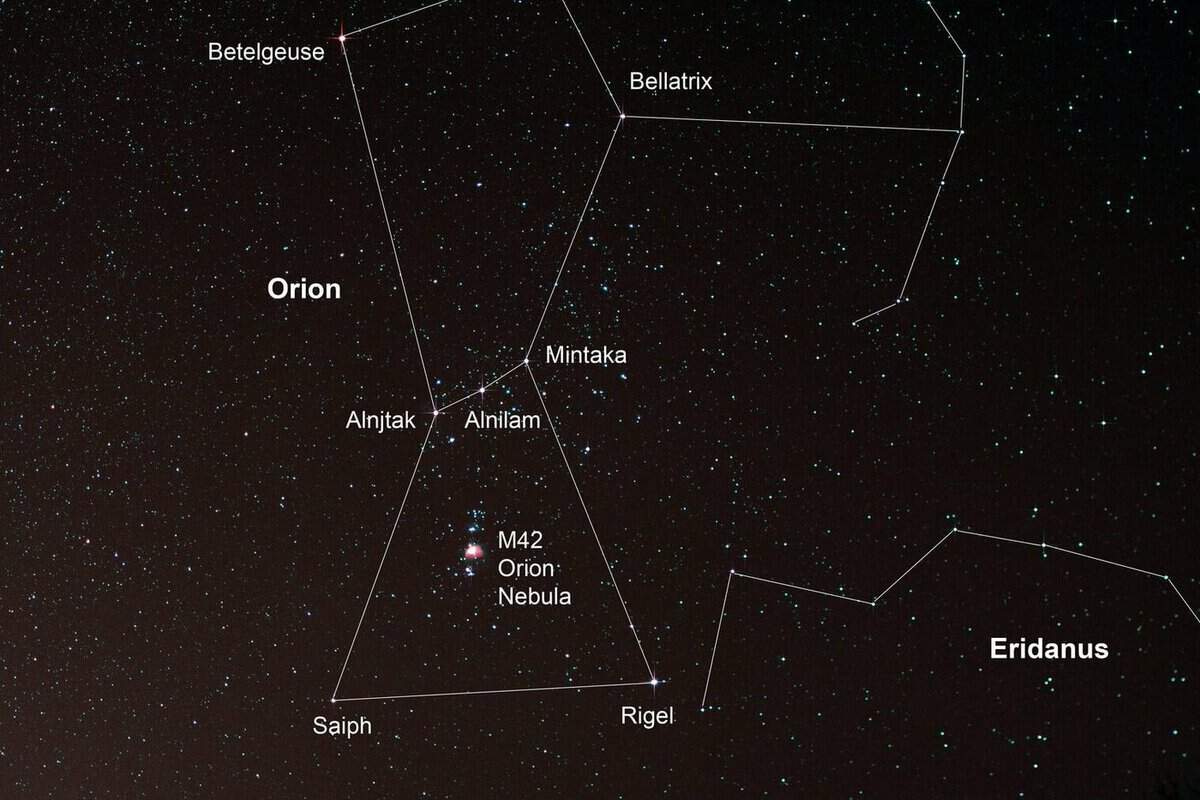Looking for something to observe in the winter sky as a novice? If you’re just starting out with astronomical observations and you already have a telescope, it’s time to get acquainted with your instrument. Familiarize yourself with the finder, practice pointing your telescope at the Moon and stars, grasp the workings of the mount, experiment with different eyepieces, and fine-tune the focus. While it may seem like a simple task, working with a telescope during astronomical observations is crucial. Without the necessary skills, you’ll find yourself easily distracted and unable to fully appreciate the awe-inspiring sight of the starry sky.
If you possess a pair of binoculars, there are certain intricacies to consider: not only must you become proficient at swiftly directing your instrument towards the desired object, but you must also ensure that the image in the eyepieces is properly aligned, equally clear, and steady despite the weight of the binoculars.
In a nutshell, if you happen to have an optical device at your disposal and are embarking on your first winter astronomical observations, make sure to take in everything around you. This includes gazing at bright stars and the mesmerizing Moon. Speaking of which, the Moon will undoubtedly offer a delightful surprise!
On the other hand, if you lack any equipment, you may actually be the most fortunate person in the world. In such a scenario, only two obstacles might hinder your stargazing aspirations: unfavorable weather conditions and excessive street lighting.
Naturally, observing celestial objects becomes impossible under a thick blanket of clouds. However, what about the issue of excessive illumination?
In major cities like Moscow and St. Petersburg, there is often only one option: to observe what is available (which is enough to start with!), or to venture outside the city – to the countryside, to a dacha, or to the forest.
In smaller cities, the night sky can still be illuminated, but it is often quite clear. In this case, you can minimize the impact of urban lighting by finding a dark spot – in a park, around a corner, or on a balcony high up in a building. It is important to avoid direct light from car headlights and streetlights shining into your eyes.
In doing so, you will be able to see stars in the sky with magnitudes of up to 3-4 stars, and if you’re lucky, even up to 4.5-5! (Of course, this requires allowing your eyes to adjust to the darkness!)
And it turns out that the misty cloud in Taurus breaks up into a small group of 5 or even 7 stars, and to the left of the Winter Hexagon, the constellation of Cancer becomes visible.
In such conditions, you have the opportunity to search for multiple deep sky objects at once, which are not stars or planets. What are these deep sky objects? Gas nebulae, scattered and globular star clusters, distant galaxies, and even more distant quasars.
Which of these objects can be observed with the naked eye on winter evenings?
1. The Andromeda Nebula
The well-known Andromeda galaxy is the farthest object in the Universe that can be observed without any optical aid. It is believed to be approximately 2.5 million light-years away! Although the Andromeda Galaxy is commonly referred to as a nebula, it is not actually a gas nebula. This naming convention is simply a result of tradition.
During winter nights, the Andromeda Galaxy can be spotted in the southwest and west directions. To locate it, start by identifying a large quadrangle of 2nd magnitude stars in the sky known as the Square of Pegasus. A chain of three stars extends upwards from the upper left corner of the square, resembling a handle attached to a square-bucket. This chain of stars represents the constellation Andromeda.
The Andromeda Nebula can be found above the central star of the knob, known as Andromeda Beta or Mirach. If we observe it in winter, we will notice two faint stars to the right and above Mirach, which are the mu and nu stars of Andromeda. The Andromeda Galaxy is located just to the right and above these stars.
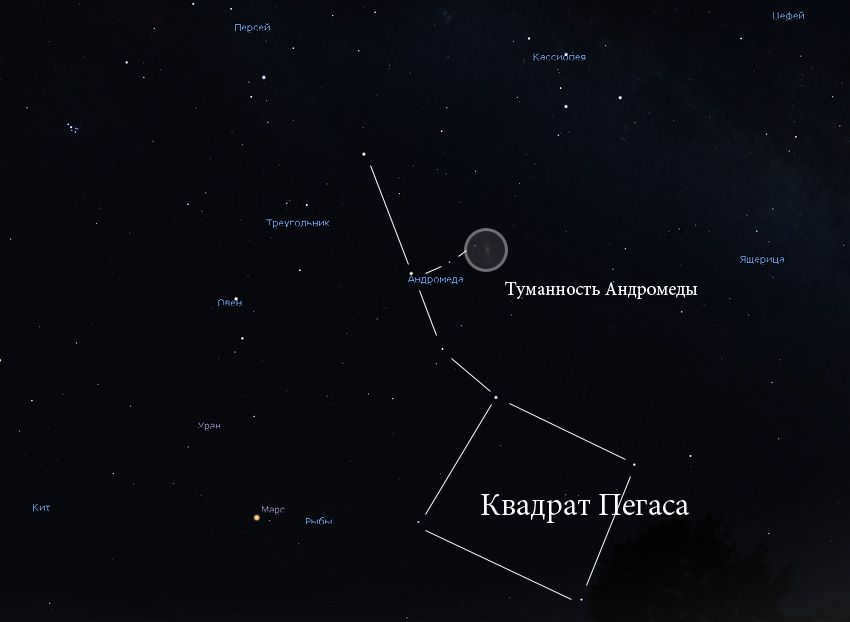
Above the beta, mu and nu Andromeda stars, you can find the Andromeda Galaxy. This celestial object appears as a small, elongated hazy patch. It may be difficult to spot in areas with a lot of light pollution, so try using your peripheral vision. To learn more about observing the Andromeda Nebula without a telescope, click here.
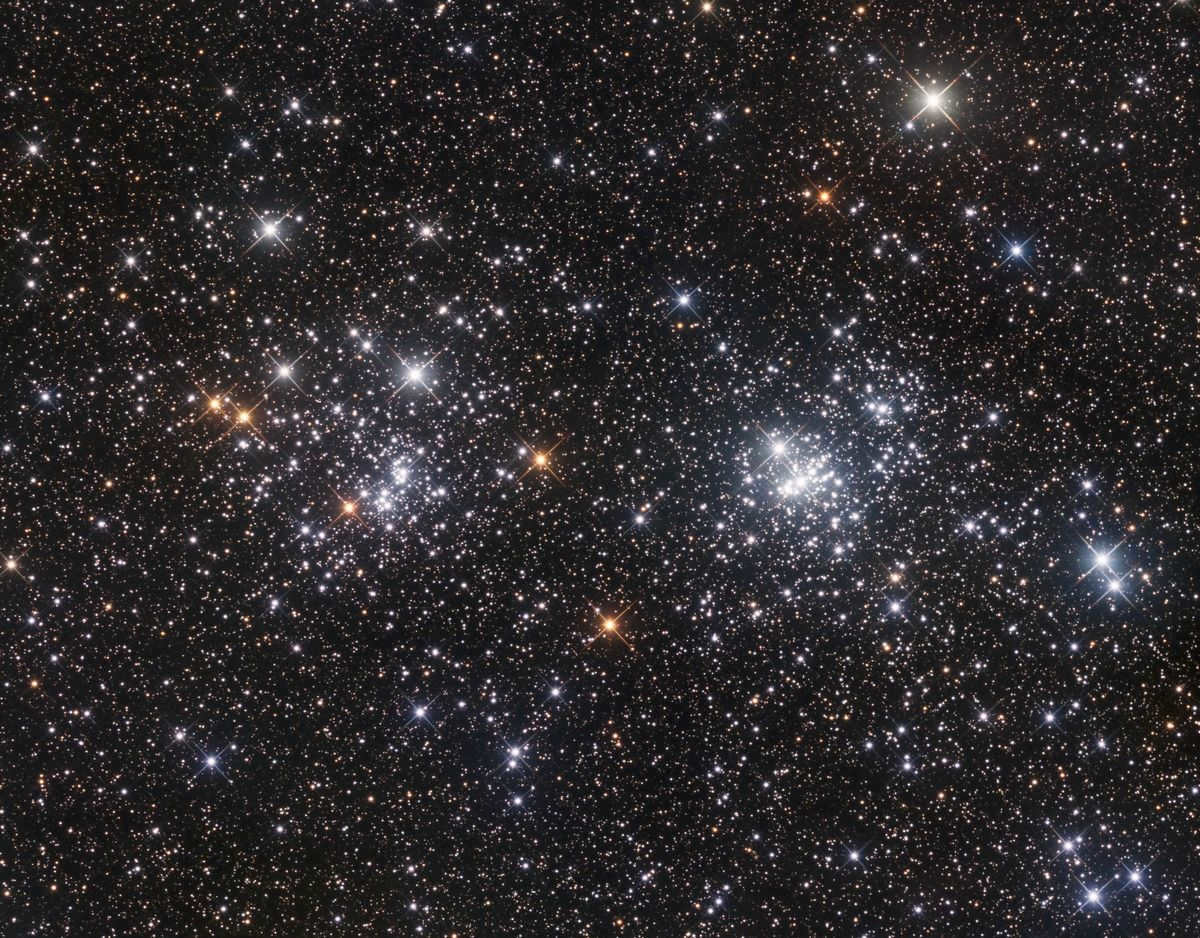
A double cluster in Perseus. Photo: astrodoc.ca
One of the highlights of our northern celestial scenery is a binary dispersed star cluster located in the constellation Perseus. It is known as Hi-Ash Perseus or χ&h Perseus. When observed through binoculars, the sight is truly remarkable: the observer can distinguish two cloudy clusters with chains of white and orange stars set against the backdrop of the densely populated star fields of the Milky Way…
With the naked eye, one can perceive an elongated patch of light in this area, smaller in size compared to the Andromeda Nebula, but subjectively brighter.
Locating the double cluster is not a challenging task. First, locate the constellation Cassiopeia. During winter evenings, it can be found high in the sky towards the southwest (or in the west by late February), positioned above the constellation Andromeda. The shape of Cassiopeia resembles the letter W in the Latin alphabet – it is truly eye-catching.
Now search for the constellation Perseus.
If you continue the line of prominent Andromeda stars towards the eastern direction (as shown above), you will reach a prominent star located at the center of the reversed “slingshot”. This particular star is known as Mirfak, alpha Perseus, and the slingshot represents the primary formation of the Perseus constellation.
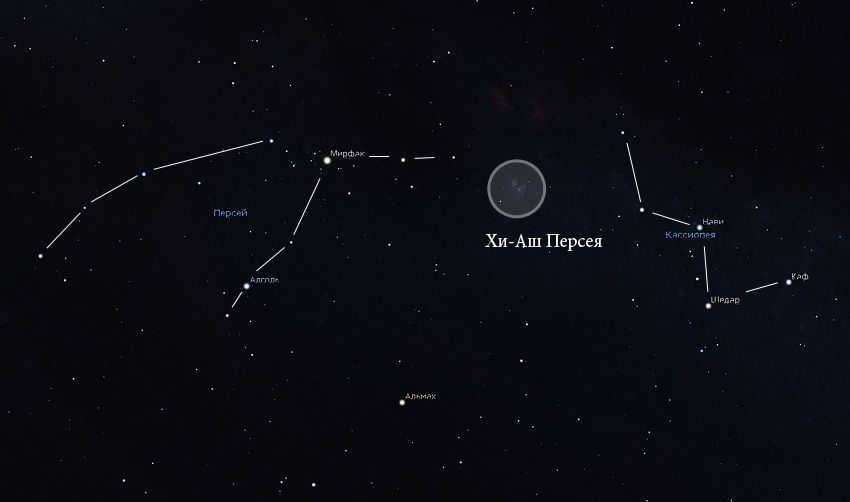
The Perseus double cluster, known as Hi-Ash, can be found nestled between the slingshot of Perseus and the constellation W Cassiopeia. It’s worth mentioning that the base of the slingshot points towards W Cassiopeia, and it is in this region that the Hee-Ash cluster of Perseus is situated.
3. Pleiades
As we journey from the west to the east, we come across the southern region of the celestial sphere, where the dazzling constellations of winter captivate our gaze. The prominent feature of the winter night sky is the constellation Orion. Above Orion, we can observe Taurus, adorned with the radiant star Aldebaran and the peculiar nebulous formation, which may resemble a cluster of stars or even a small ladle, depending on the atmospheric conditions. These celestial wonders are none other than the renowned Pleiades, arguably the most brilliant celestial object visible in our sky.
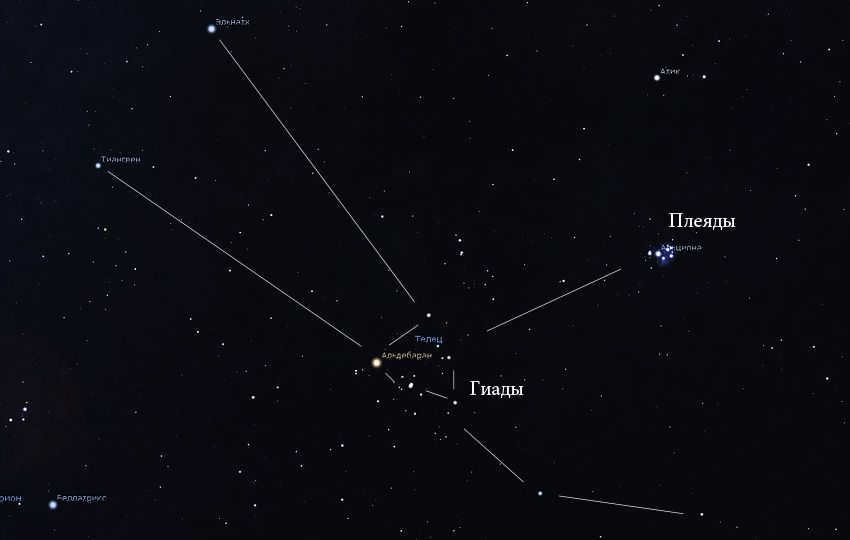
There are two star clusters scattered in the Taurus constellation – the Pleiades and the Hyades. Picture: Stellarium
The Pleiades is one of the closest dispersed star clusters to Earth: it is located 450 light-years away, which is 16 times closer than the double cluster in Perseus. The proximity of the Pleiades is also evident in its appearance – in a dark and clear sky, the brightest stars of the cluster can be easily seen individually. A person with normal vision can count 5 or 7 stars in the cluster, while those with sharp eyesight can see up to 10 stars in the Pleiades.
The view of the Pleiades through binoculars is stunning – dozens of stars can be observed within the field of view of a 50-mm instrument!
Located very near to the Pleiades in the constellation Taurus is another group of stars that is even closer to Earth. The star Aldebaran is situated on the outskirts of this cluster, although it is not a part of it. We are referring to the Hyades.
In ancient maps, the head of Taurus was depicted at this position, and the reddish Aldebaran symbolized the eye of an enraged animal. The stars of the Hyades are three times nearer to Earth than the Pleiades, so they are spread out over a larger area. Due to this, the cluster does not appear as remarkable as the Pleiades, especially in urban skies.
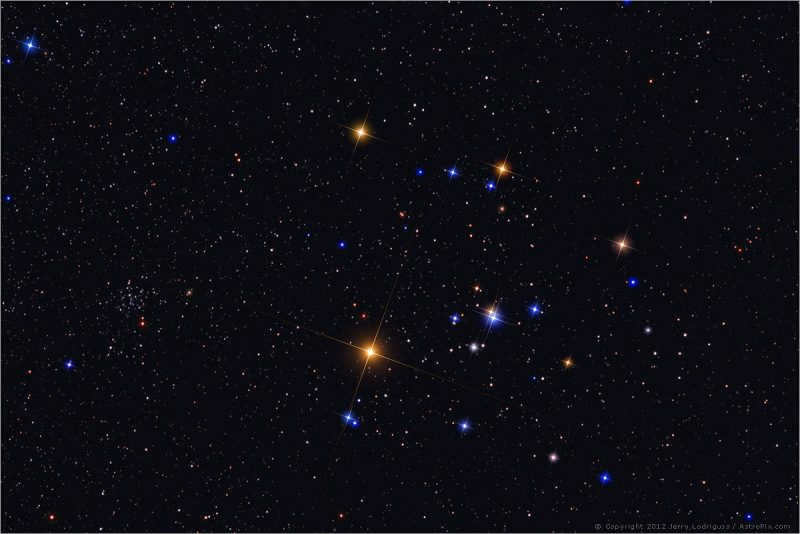
The Hyades and the star Aldebaran (the brightest star in the picture). Image: Jerry Lodriguss/AstroPix.com
By the way, the term “cluster” suggests that the stars within the cluster are interconnected through gravitational forces, share a common history, and were born from a single cloud of gas and dust around the same time. In reality, all the stars within the Pleiades cluster are related, just like the stars within the Hyades cluster.
5. The Great Orion Nebula
Coming in at number five is the renowned Orion Nebula, also known as the Great Orion Nebula.
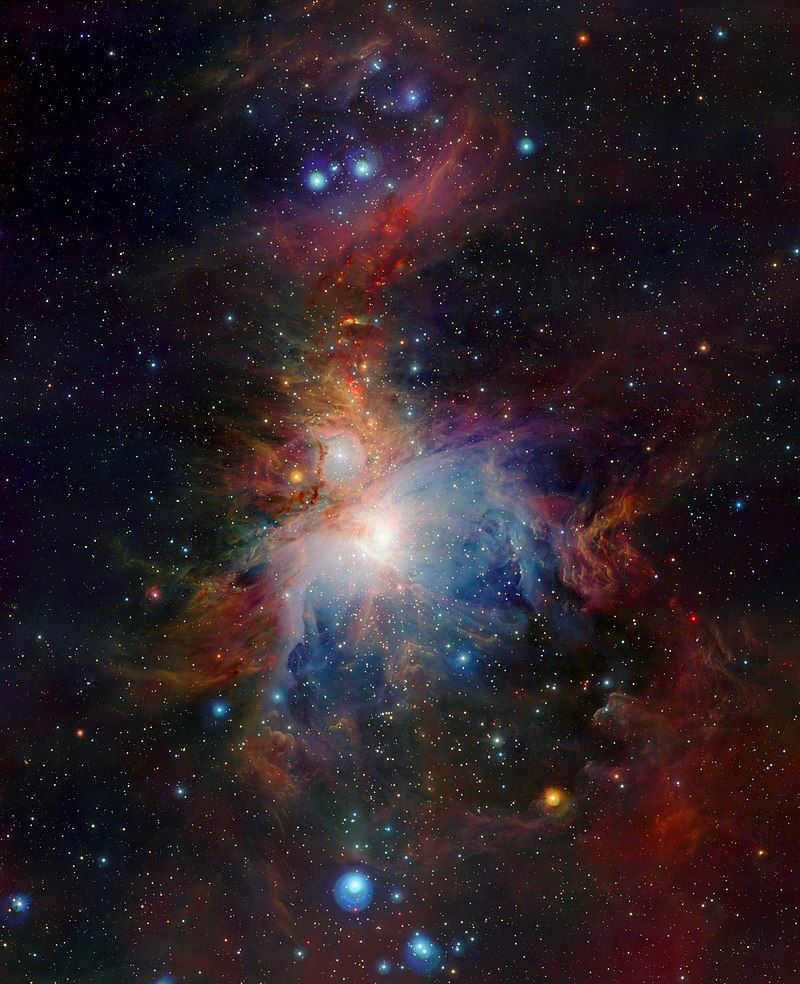
The Great Orion Nebula. Photo: ESO/J. Emerson/VISTA
Unlike the Andromeda Nebula, which is actually a massive spiral galaxy, the Orion Nebula is indeed a true nebula! It consists of a luminous cloud of interstellar hydrogen that forms a part of our very own galaxy, the Milky Way. Situated approximately 1,400 light-years away from Earth, the Orion Nebula showcases a remarkable mass of at least 2000 solar masses.
It is worth mentioning that this hydrogen cluster in the Orion Nebula is far from being idle. Presently, hundreds of newly forming stars, varying in mass, are emerging within its vicinity. Among these stars, some will bear a striking resemblance to our Sun, while others will surpass the brightness of our daylight. However, most of these stars will be smaller, cooler, and dimmer in comparison.
The Orion Nebula serves as one of the primary locations within the Milky Way where new stars and planets come into existence. Approximately 5 billion years ago, our own Sun took shape within one of these nebulae.
What is the method for locating the Orion Nebula in the night sky?
It can be found situated in the middle of the asterism known as The Sword of Orion. Orion, the hunter himself, is comprised of seven brilliantly shining stars, with three stars forming a straight line in the center. This grouping is commonly referred to as Orion’s Belt. Just below the Belt lies the Sword of Orion, which, during the winter season when the constellation is positioned in the southern sky, appears vertically aligned (with the Belt slightly tilted towards the horizon).
The Orion Nebula resides at the heart of the Sword and presents itself as a rather prominent yet somewhat indistinct star. Observers often find themselves struggling to bring the star into sharp focus.
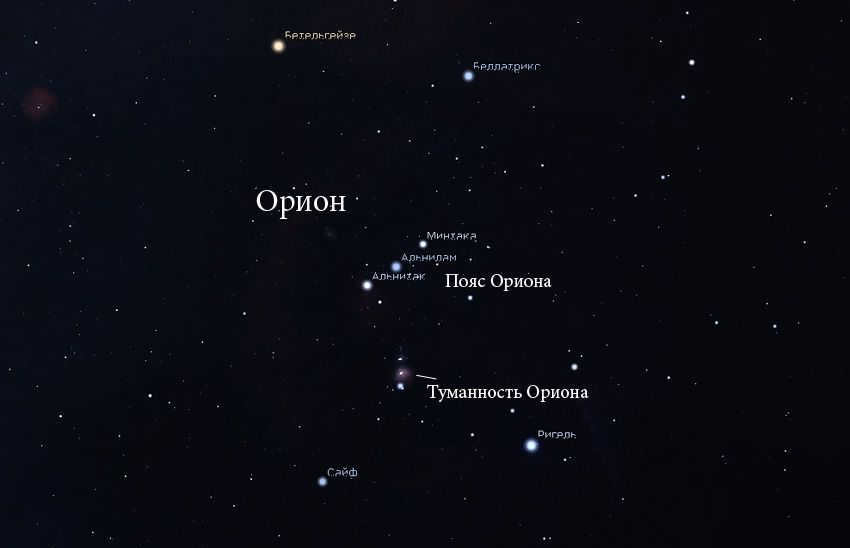
The Orion Nebula can be found at the center of the Sword of Orion. Image: Stellarium
Therefore, there are five simple celestial objects that can be observed in the winter sky at night without the need for a telescope. In urban areas, their visibility will depend on various factors such as smog, dust, and light pollution. Begin with the Pleiades and Hyades as they are the brightest. Next, try to locate the Orion Nebula and then proceed to the double cluster. Finally, finish with the Andromeda Nebula, which is the most challenging object to spot among the mentioned ones.
It is worth mentioning that outside urban areas, in rural locations, with the necessary expertise, these objects can be easily found and observed with great clarity.
Take note that within this group, there are various celestial objects such as star clusters, nebulae, and even a far-off galaxy! Yet, when observed without aid, nearly all of these objects appear as hazy dots. To truly uncover their essence, more powerful optical instruments are required!
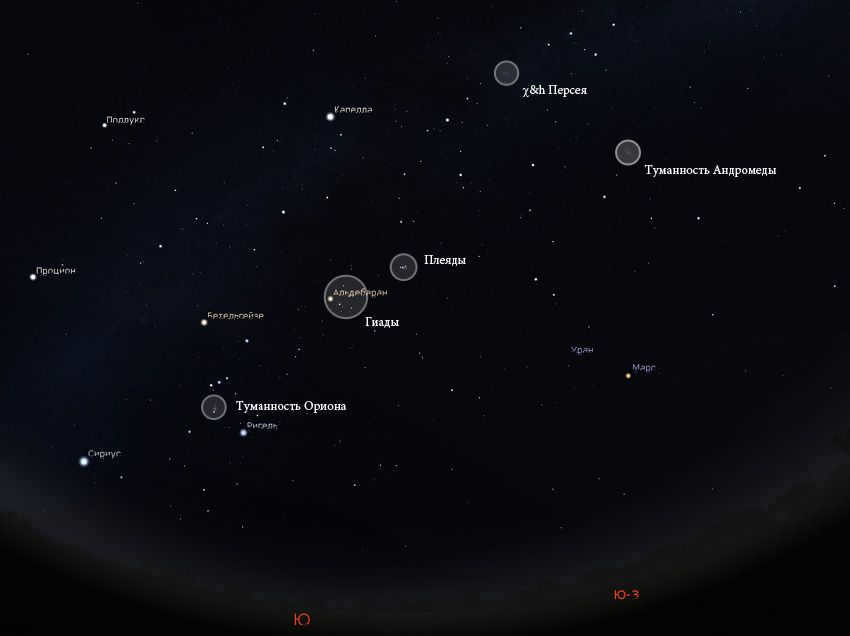
There are five celestial objects that can be seen with the naked eye in the winter sky. As shown in the Stellarium image above, these objects are easily visible and can help you navigate the night sky. Observing these objects without any assistance allows you to become familiar with the stars and feel a connection to them. However, the real magic happens when you view these objects through binoculars or a telescope. They become even more fascinating and vibrant, revealing details that are not visible to the naked eye. It’s truly a remarkable experience! And of course, it’s always satisfying to spot a bright star and recognize it, like saying “Hey, I know you! You’re Aldebaran surrounded by Hyades!”
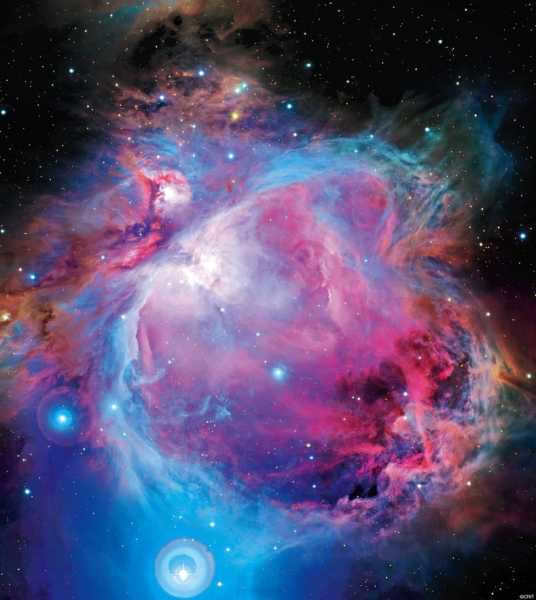
The well-known and expansive Orion Nebula (M42, NGC1976), located in the constellation of Orion, is one of the most brilliant nebulae visible in the night sky.
Essential details
The Orion Nebula, also known as the Great Orion Gas-Dust Nebula, is the nearest celestial region where stars are currently being formed. This nebula is home to numerous young planetary systems composed of gas and dust. Within M42, astronomers have identified approximately 700 stars in the process of formation. The Hubble telescope has captured an exquisite panoramic image showcasing these protostars.
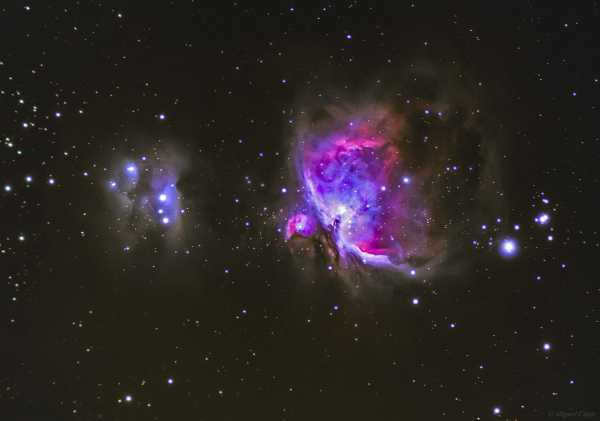
The photo was captured in Serra de Aire, a location situated in Portugal. The equipment used for the shoot included a Canon 60Da camera with the following settings: ISO 2500, Exposure: 21 seconds, Aperture: F/7, and a focal length of 570mm in combination with an Astro Professional ED 80 lens. The photo is a composite of 51 frames merged together using the Maxima DL 5 program. The credit for this stunning image goes to Miguel Claro.
The Orion Nebula, also known as M42, is a diffuse nebula. In many visible range images, the red areas within the nebula are produced by hot hydrogen gas. The blue color, on the other hand, is caused by dust particles reflecting the light emitted by hot blue stars. The red hue is the outcome of recombination in the Hα emission line at a wavelength of 656.3 nm. The blue-violet tint represents the reflected emission from the massive O-class stars located at the center of the nebula. M42 is just a part of a much larger complex of molecular clouds present in the Orion constellation, which also includes M78 and the Horsehead Nebula.
The place where it is situated
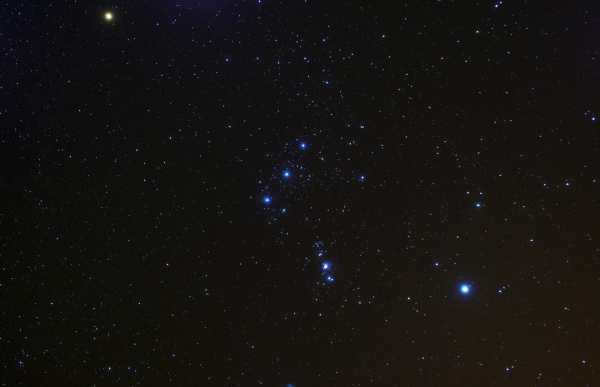

The trio of stars known as Alnitak (ζ Orionis), Alnilam (ε Orionis), and Mintaka (δ Orionis) are situated in the center of the photograph and are commonly referred to as Orion’s Belt.
The Great Orion Nebula is easily identifiable to the naked eye due to its brightness, boasting a stellar magnitude of 4. It is positioned approximately 1,500 light years away from Earth. With a diameter of around 30 light years, M42 serves as a vast cocoon within which numerous stars are born.
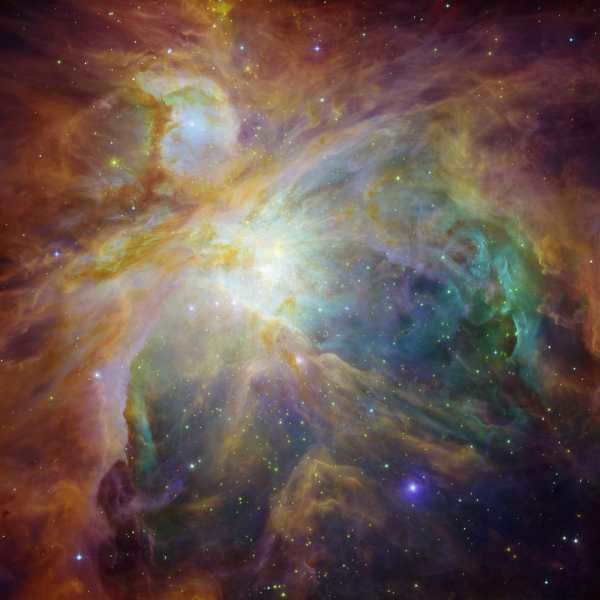

M42: an image captured using infrared, ultraviolet, and visible light.
Physically connected to the Orion Nebula is a smaller nebula called M43. It appears to be slightly separated from M42 by a dark strip of dust. A cloud of interstellar dust can be seen near the left border of M42, reflecting the light emitted by young, hot stars. This cloud is composed of three distinct regions known as NGC 1977, NGC 1975, and NGC 1973.
A collection of pictures showcasing the mesmerizing nebula
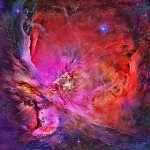
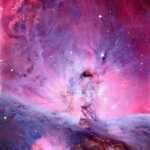
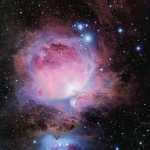
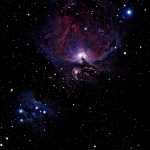
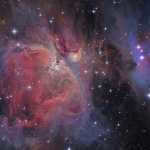
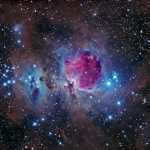
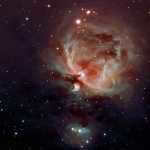
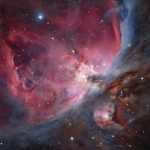
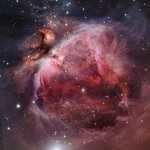
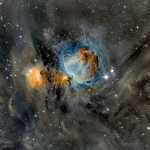

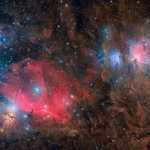
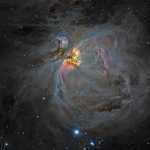
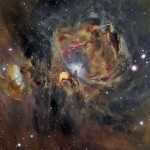
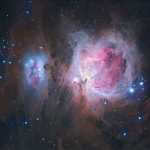
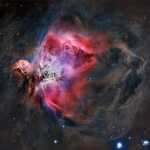
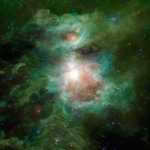
Investigating M42
Accurately determining distances in outer space can be challenging, particularly in certain regions of our Milky Way. Stars that appear to be close to each other can actually be separated by hundreds or even thousands of light-years. This becomes even more complicated when trying to measure distances from Earth.
A group of scientists recently utilized a high-resolution 340-megapixel camera installed on the CFHT, also known as the Canada-France-Hawaii Telescope, to examine the star-forming area commonly referred to as M42.
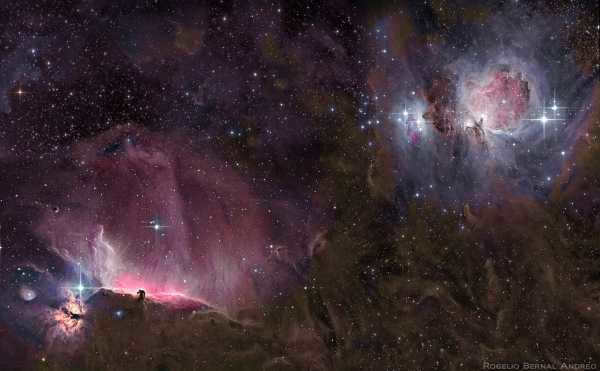
A photograph captured from Earth using a technique called slow shutter speed
Scientists have reached the conclusion that the nebula’s two large star groups are actually positioned in front of it and exist as separate formations. While M42 can be seen with the naked eye, its true nature was not unveiled until the advent of the first telescopes in 1610. This expansive and dynamic region, where stars are actively forming, is situated approximately 1500 light-years away. The diverse stars within it have provided astronomers with a reference point for studying various aspects of star formation.
ESAC, the European Space Center for Astronomy, conducted a study which revealed that a massive star cluster named NGC 1980 is positioned in front of the nebula and consists of around 2000 stars that are distinct from it.
It was revealed that M42 had a plethora of intriguing surprises.
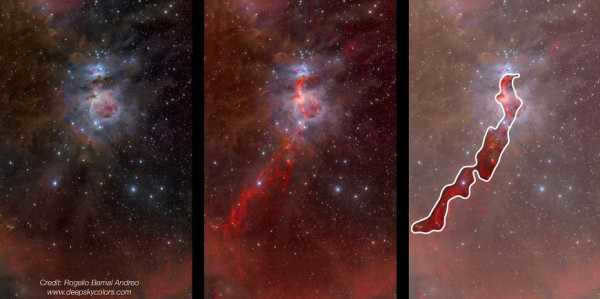
The L1641W molecular hydrogen cloud was found by combining CFHT observations with previous studies conducted by Herschel, Spitzer, WISE, and XMM-Newton. This discovery revealed the existence of another cosmic cloud composed of molecular hydrogen.
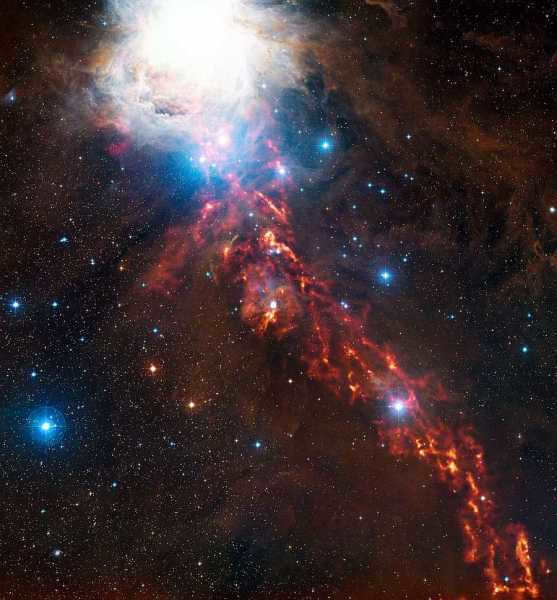
A stunning depiction of the star-forming area within the Orion Nebula is captured in this composite image.
Presenting itself as a mesmerizing band of flames in the celestial expanse, a space cloud in the Orion constellation has been visualized in a breathtaking manner. The hues of orange beautifully portray the feeble glow radiated by particles of frigid interstellar dust.
The process behind the observations
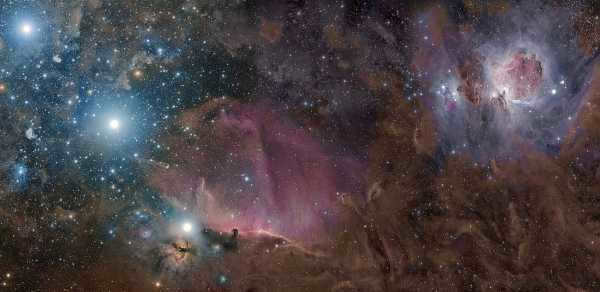
The APEX telescope (Atacama Pathfinder Experiment), located in Chile, was utilized for the examination.
Gas and dust clouds serve as the building blocks for stars. However, these minuscule particles of dust create a barrier that obstructs our view of what lies within and beyond these clouds in visible light, thereby impeding the observation of star formation processes.
This is why astronomers must employ instruments capable of detecting other wavelengths of light. At submillimeter wavelengths, dust particles emit a glow due to their temperature being a few tens of degrees above absolute zero.
The APEX telescope, equipped with a submillimeter camera, situated at an altitude of 5000 meters above sea level, proves to be the perfect tool for such observations.
This extraordinary new depiction showcases only a fraction of the vast and intricate structure known as the Orion Molecular Cloud, positioned within the constellation bearing the same name. Present within this expanse are a diverse array of luminous nebulae, youthful and energetic stars, as well as frigid dust clouds… This expansive area spans across hundreds of light-years and is situated approximately 1350 light-years distant.
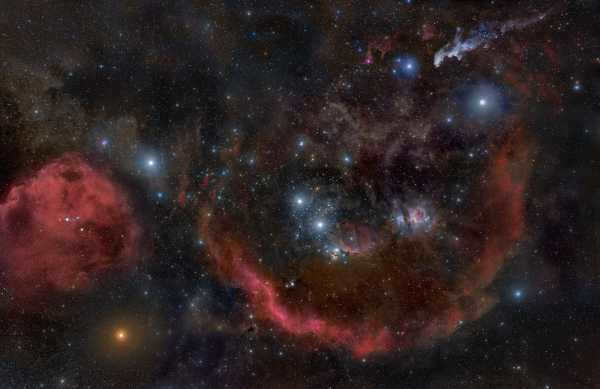

A panoramic view of the surrounding area of the Orion Nebula, formed by merging 32 individual images
Formation of stars in the nebula
The Orion Nebula, also known as M42, is situated within the constellation bearing the same name. This celestial object can be observed with the naked eye as a prominent feature in the center of Orion’s “sword”. It represents the brightest segment of the expansive stellar nursery where the birth of new stars takes place. Additionally, it stands as the nearest site to Earth where star formation occurs.
The gravitational compression and the effects of stellar winds contribute to the creation of stunning fibrous structures, referred to as “leaves” and “bubbles”, within dust clouds.

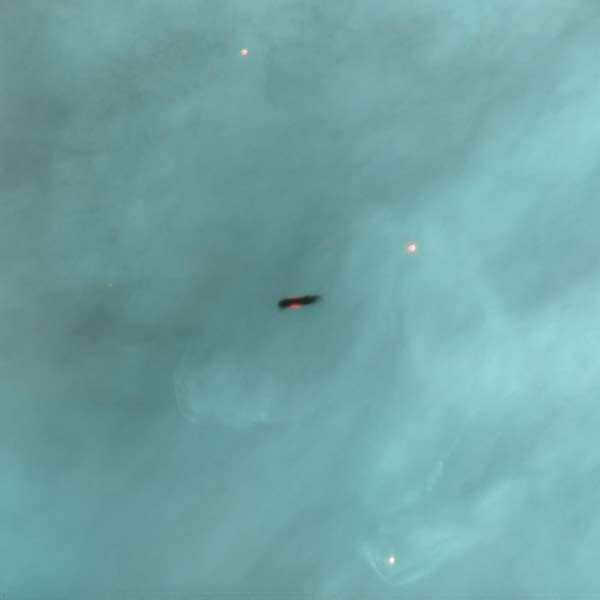
Panoramic image of the region surrounding NGC 1999
A nascent solar system
Astronomers have utilized this and additional information collected by APEX, along with imagery from the Herschel Space Observatory, to meticulously investigate the Orion constellation in search of the precise location of a protostar – a stellar entity in its early formative stages.
Thus far, they have successfully identified 15 entities that exhibit significantly higher brightness levels in longer wavelengths of light compared to shorter wavelengths.
These newly uncovered and rare objects are highly likely to be among the most juvenile protostars ever discovered, consequently propelling astronomers closer to the exact time of stellar formation.
New snapshot of the nebula
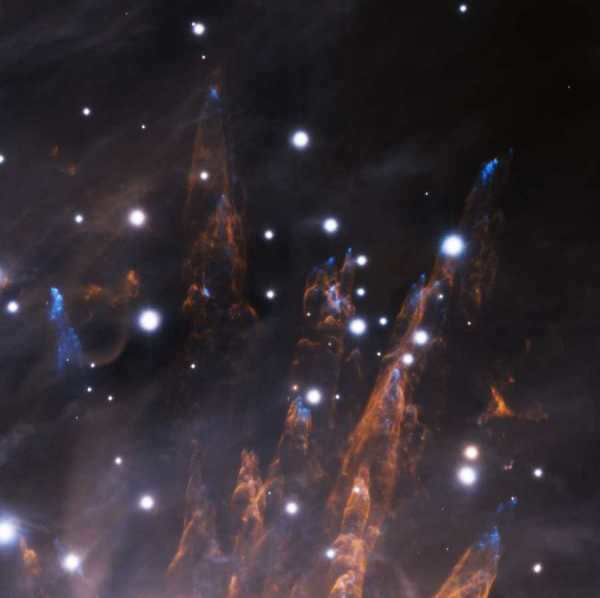

A recently taken picture of the Orion Nebula by the Gemini telescope
The image above was acquired using the most advanced adaptive optics system on the Gemini Telescope.
In the recent picture, clusters of blue interstellar gas, resembling high-speed “bullets,” are seen shooting out from the area of intense star formation beyond its boundaries.
These “bullets” traverse through clusters of neutral hydrogen and heat it up, resulting in the formation of pillars.
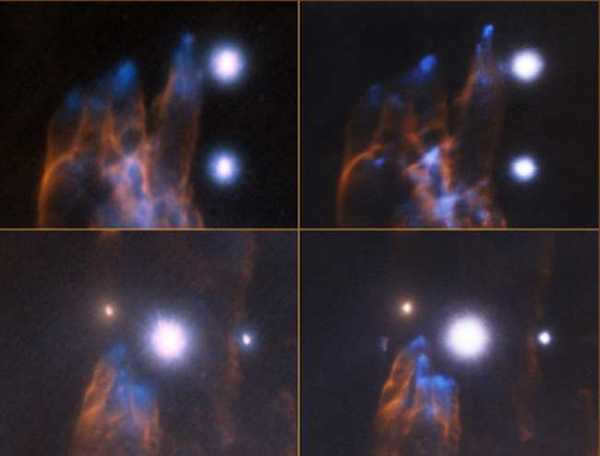
Comparison of images captured by various telescopes
Usage of Adaptive Optics
Optical instruments with a wide field of view (85 angular seconds across) showcase the remarkable efficiency and consistent correction across the entire field.
Through the combination of five laser reference stars and multiple deformable mirrors, the adaptive optics capabilities in astronomy are significantly enhanced. The recently implemented system at the Gemini Telescope in Chile is the first of its kind to utilize multiple laser reference stars.
Photos taken by the Hubble Telescope
There are some amazing images that have been captured by the Hubble telescope, including a breathtaking view of M42. By zooming in to the maximum extent, you can even catch a glimpse of protoplanetary star systems.
The Spitzer Telescope and its Nebula
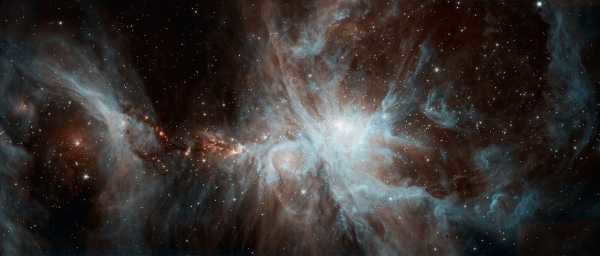
The Spitzer telescope captures an image of a nebula.
NASA’s Spitzer telescope reveals a breathtaking view of a cluster of young, vibrant stars in this stunning cosmic display.
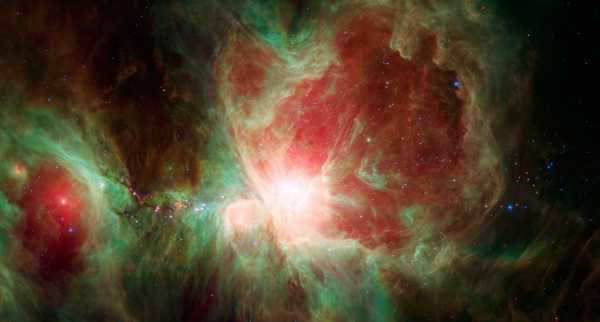
The fluctuations in luminosity detected by the Spitzer telescope can be attributed to a range of factors. These include the development of both cold and hot regions on the surface of the celestial body, which in turn affect its overall brightness level.
The Benefits of Infrared Spectrum Studies
Studying celestial objects in the infrared spectrum offers several advantages. For example, when a star is surrounded by dusty material, its brightness is weakened. However, an infrared telescope can effectively monitor these stars and provide valuable data about their changing brightness. In particular, the hottest stars, known as the trapezoid region, appear as bright spots, such as the one seen in the center of the image. These stars emit radiation and stellar wind, shaping the surrounding nebula.
This image, captured by the Spitzer telescope, marks the beginning of a new phase after all the coolant vaporized in May 2009, enabling a “warm” mission. The infrared telescope used in this mission captures light in the 3.6-micron (blue) and 4.5-micron (orange) bands.
The high-resolution image of the Orion Nebula is available.
Locating the Orion Nebula
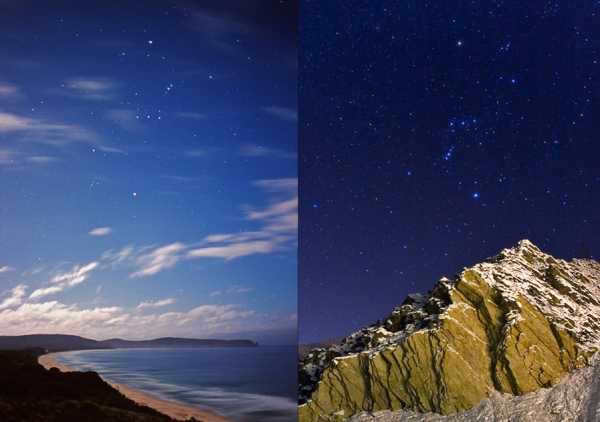
Observing the Orion constellation both at sea and in the mountains
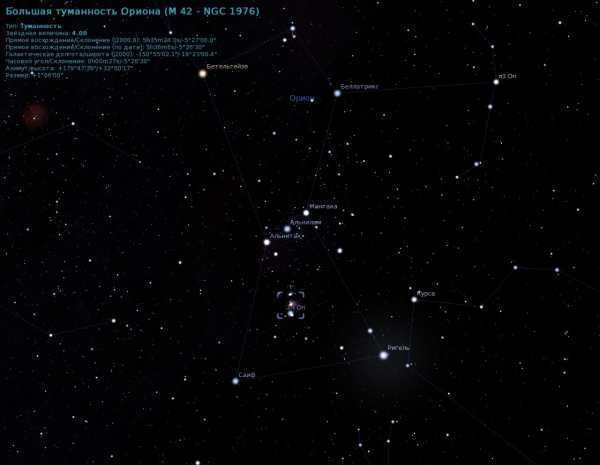
The Stellarium star map displays the stunning Great Orion Nebula.
To locate the Great Orion Nebula amidst the stars, simply look for it with the naked eye below and to the left of the three-star belt, which is easily identifiable in the well-known constellation Orion. For those residing in Russia, the optimal time for observation is during the Winter season. During this time, it remains visible in the sky, positioned fairly high above the horizon.
When observed through an amateur telescope, the nebula appears as a diffuse cloud of gray hue, exhibiting a distinct shape. By utilizing an oxygen filter, the contrast can be significantly enhanced, allowing for a more detailed view.
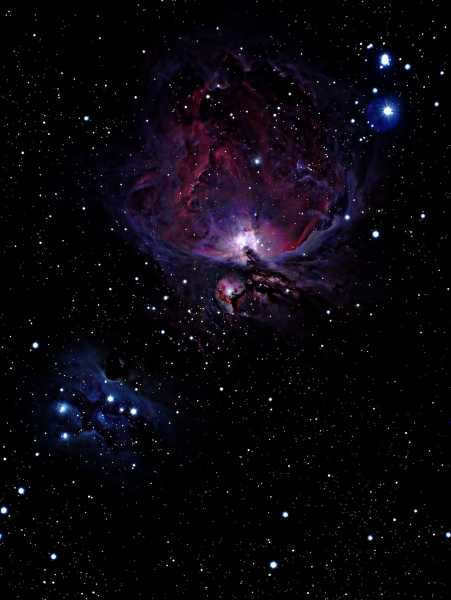
An impressive photograph of the Orion Nebula taken by an amateur astronomer
The Orion Nebula is a stunning celestial object that can be observed with telescopes that have an aperture of 300 mm or more. It is known for its vibrant colors and its size, which allows even binoculars to capture its beauty.
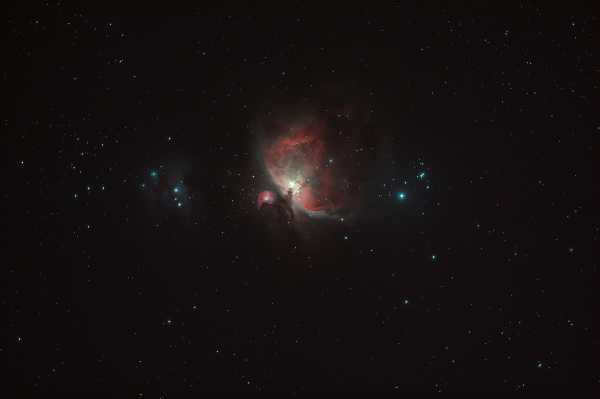
An amateur photograph was taken with a total exposure time of 57 minutes.
Due to its brightness, it is an excellent choice for beginners. Even with just a 200-300 mm lens, you can already capture the nebula in your pictures. However, to achieve significant results, a slow shutter speed is necessary to prevent blurring of the image. For this purpose (without purchasing a telescope with a motorized mount), photo mounts such as AstroTrac and nanoTrack are suitable. They allow you to capture images with long exposure without any “blurring”.
By utilizing a beginner’s telescope equipped with hourly adjustment and guidance (to avoid any distortion in the image), one can capture impressive photographs. The longer the exposure (shutter speed of the image), the more distinct the details will appear. You can find examples of these stunning shots in our collection of nebula photos.
Journeying to the Orion Nebula
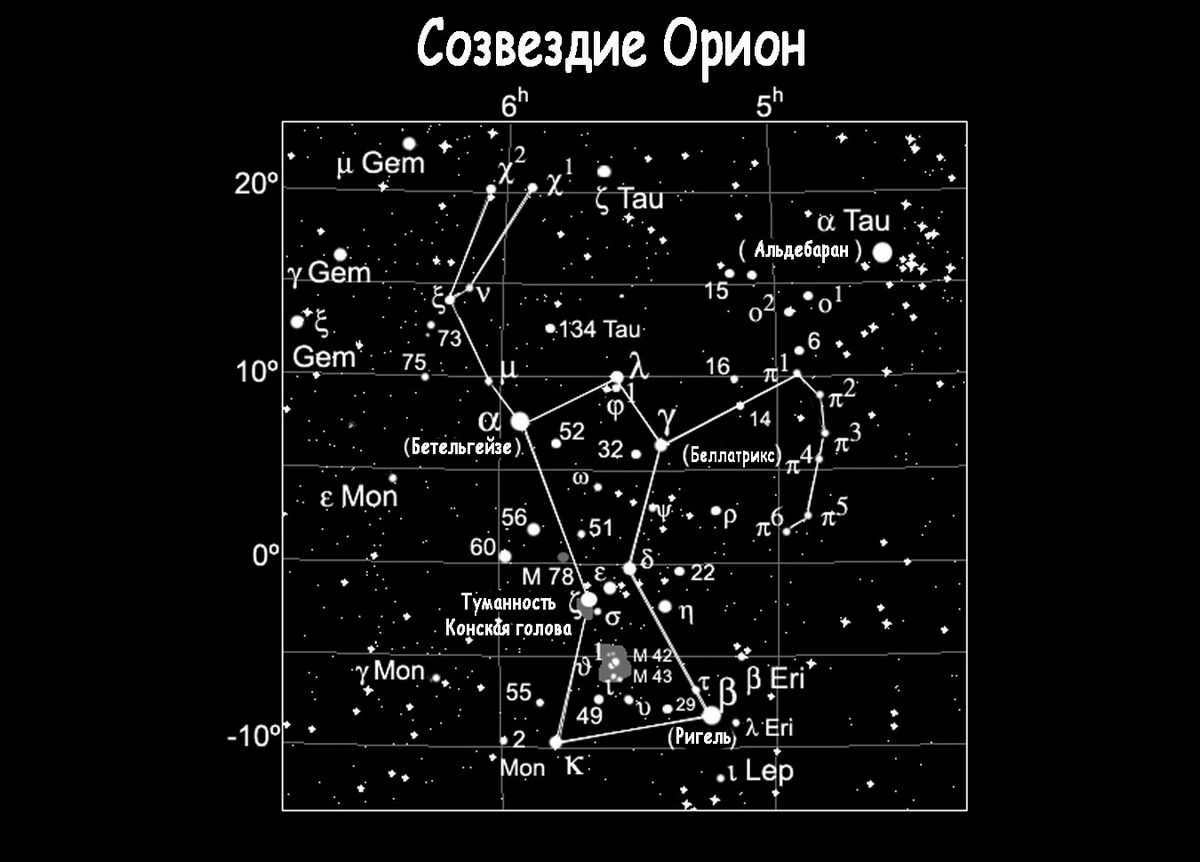
Orion constellation is widely regarded as one of the most stunning sights in the entire night sky. It boasts a collection of exceptionally bright stars that, when connected together, form the shape of a mighty hunter. Its figure extends from the southeastern region, pointing towards the magnificent blue giant Sirius, located in the constellation of the Big Dog. On the opposite side, it directs towards the radiant red star Aldebaran, which can be found in the constellation Taurus. Occupying an expansive area of approximately 594 square degrees in the celestial sphere, Orion is easily identifiable due to its striking silhouette.
The constellation Orion
Observation
Noticing
Witnessing
Perception
Examining

The constellation Orion is visible during the late summer, fall, and winter seasons. It can be observed until mid-April and is present throughout Russia, making it a significant part of the autumn-winter landscape.
Fascinating entities
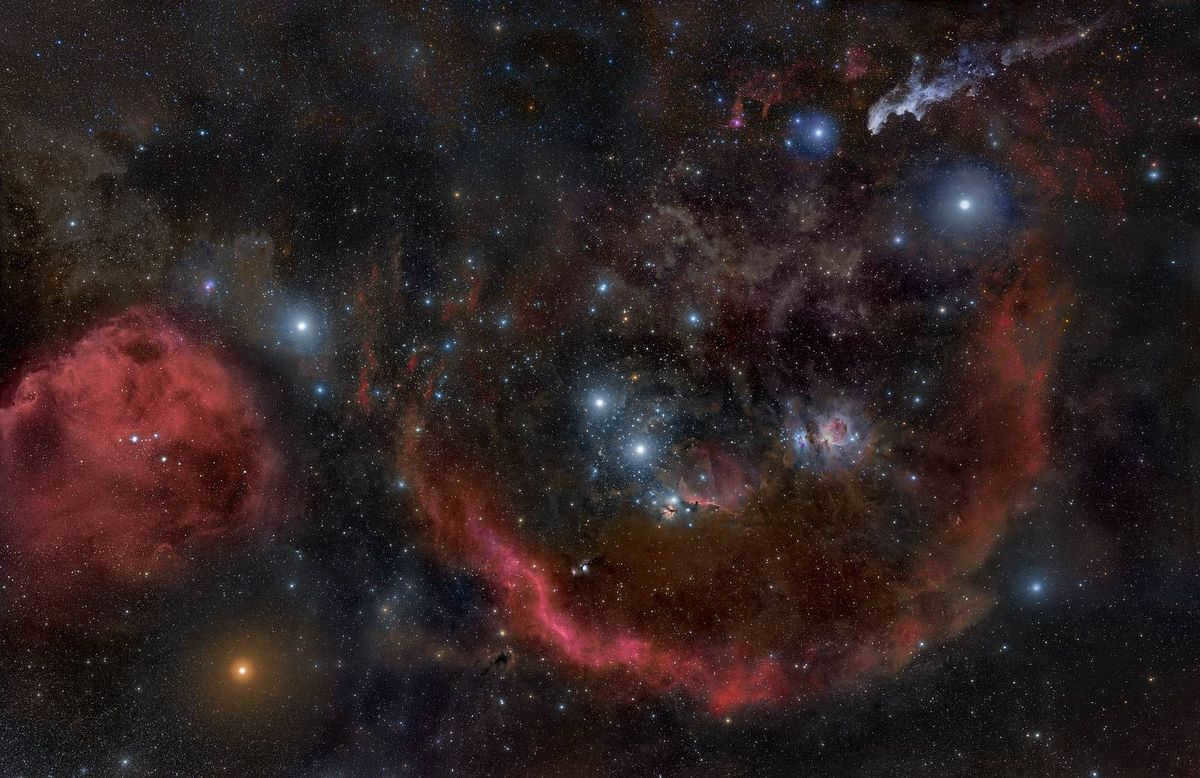
Located in the belt of Orion, there are Nebulae that can be seen in photos.
If you observe the constellation on a night without the moon or clouds, you will be able to easily count 200 stars. Within this constellation, there are certain objects that form the shape of Orion. These objects consist of three extremely bright stars with a stellar magnitude of zero. Additionally, there are five stars within the outline that have a second stellar magnitude, and four stars with a third stellar magnitude. Among these stars, there are variables, nebulae, hot star associations, and asterisms. Two notable bright stars within the Orion constellation are Rigel and Betelgeuse.
The celestial bodies
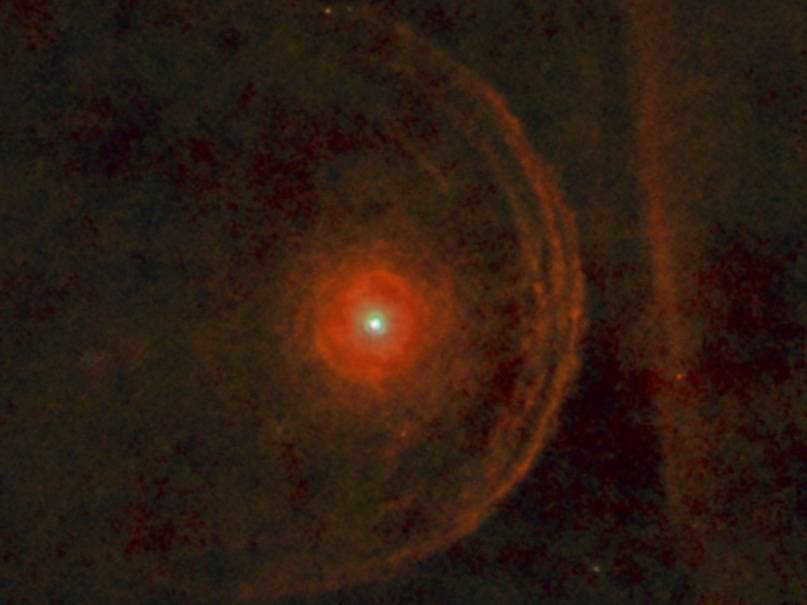
Betelgeuse is a red supergiant star located in the constellation Orion. The name Betelgeuse is derived from the Arabic word for “armpit.” This massive star exhibits irregular variability, with its brightness ranging from 0.2 to 1.2 magnitudes. On average, Betelgeuse has a brightness of 0.7 magnitudes. Situated approximately 430 light years away from Earth, this celestial giant shines 14,000 times brighter than our sun.
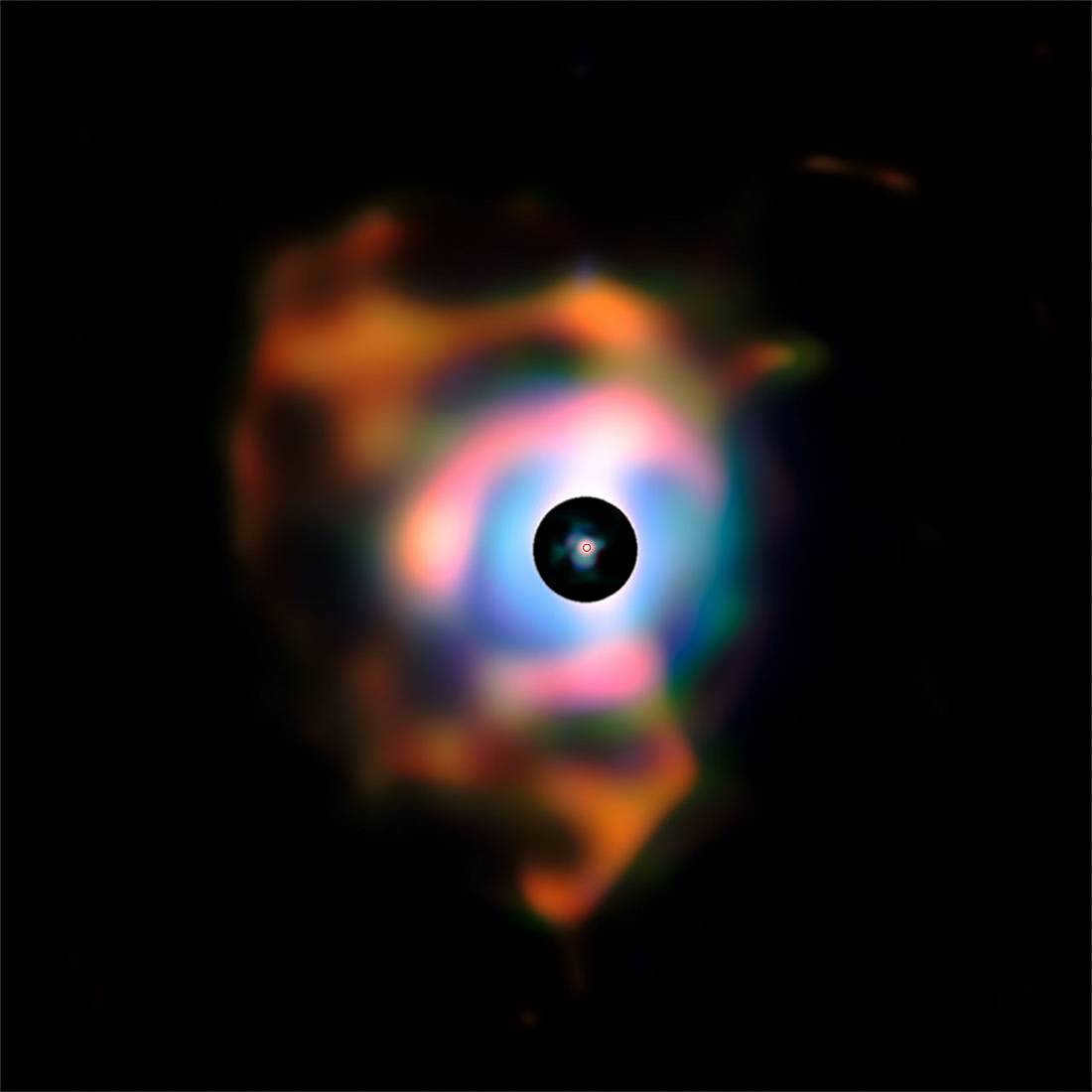
Photograph of the Nebula surrounding the vibrant red supergiant star, Betelgeuse
Betelgeuse, an immense star, holds the distinction of being one of the largest stars ever observed. If we were to replace our Sun with Betelgeuse, it would occupy the space between Earth and Mars at its closest point. At its farthest distance, the surface of this extraordinary star would extend as far as the orbit of Jupiter. The size of Betelgeuse surpasses our Sun’s volume by a remarkable factor of approximately 160!
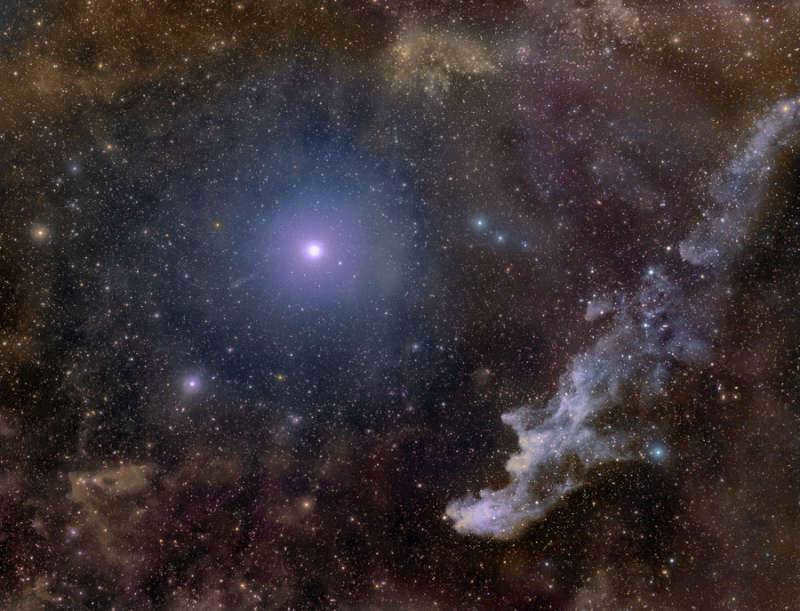
Photograph of the Rigel star and the Witch’s Head Nebula
Rigel, a blue-white supergiant, is known as the “foot” in Arabic. With an almost zero stellar magnitude, it is located 770 light years away from Earth. This giant star has a surface temperature of 11,200 K and a diameter 68 times larger than our Sun, measuring 95 million kilometers. Rigel is the most powerful star in close proximity to us. In ancient Egyptian mythology, Rigel was associated with Sah, the king of the stars and the patron saint of the dead.
Star systems
It is important to mention the Orion constellation’s θ star system, located in the Sword. It forms the Trapezium of Orion and consists of four components.
A video compilation made from various images captured by the Hubble Space Telescope.
Galactic Clouds
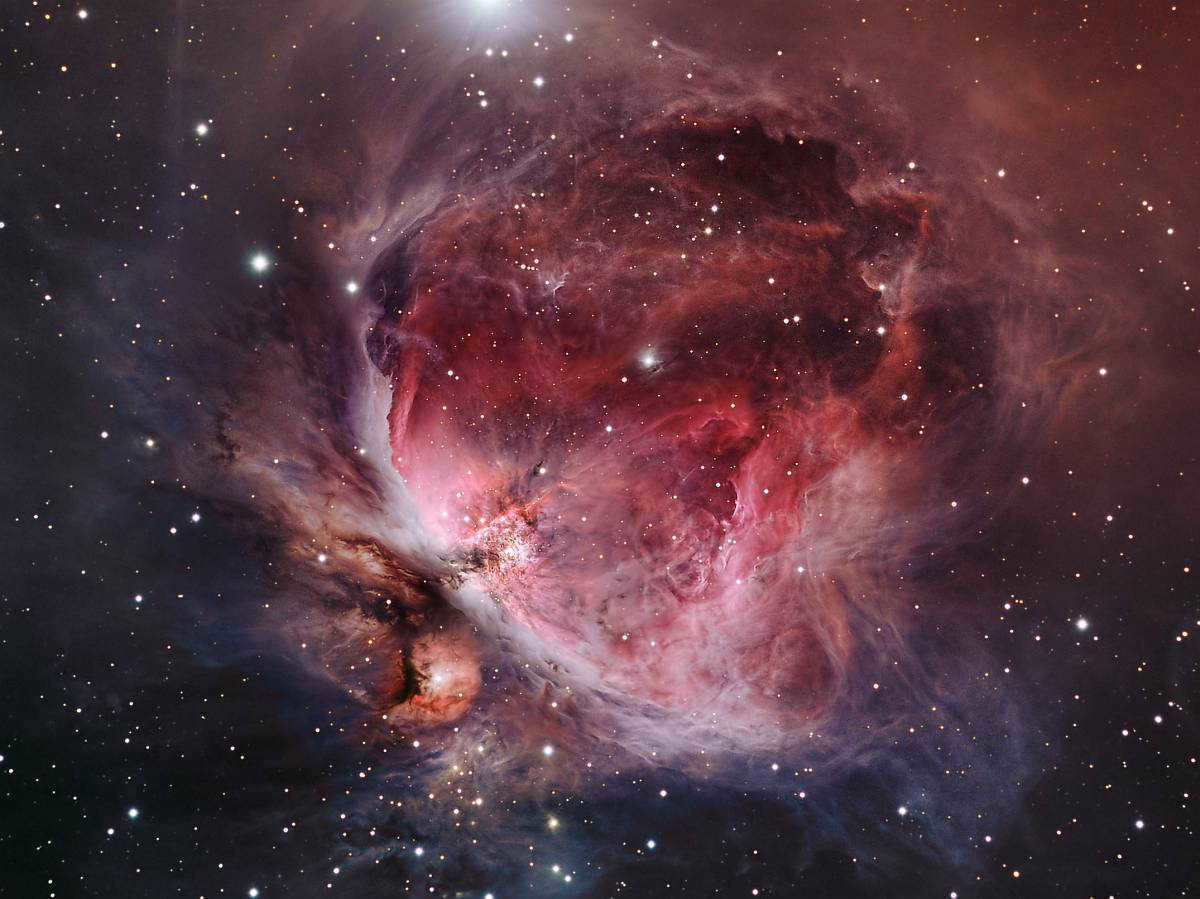
The Orion Nebula is easily visible in a small telescope. Astronomers were able to capture the first photographs of this nebula.
Watch a 3D Animation of the Orion Nebula
All the images below were captured using different filters and exposures over a period of many hours.
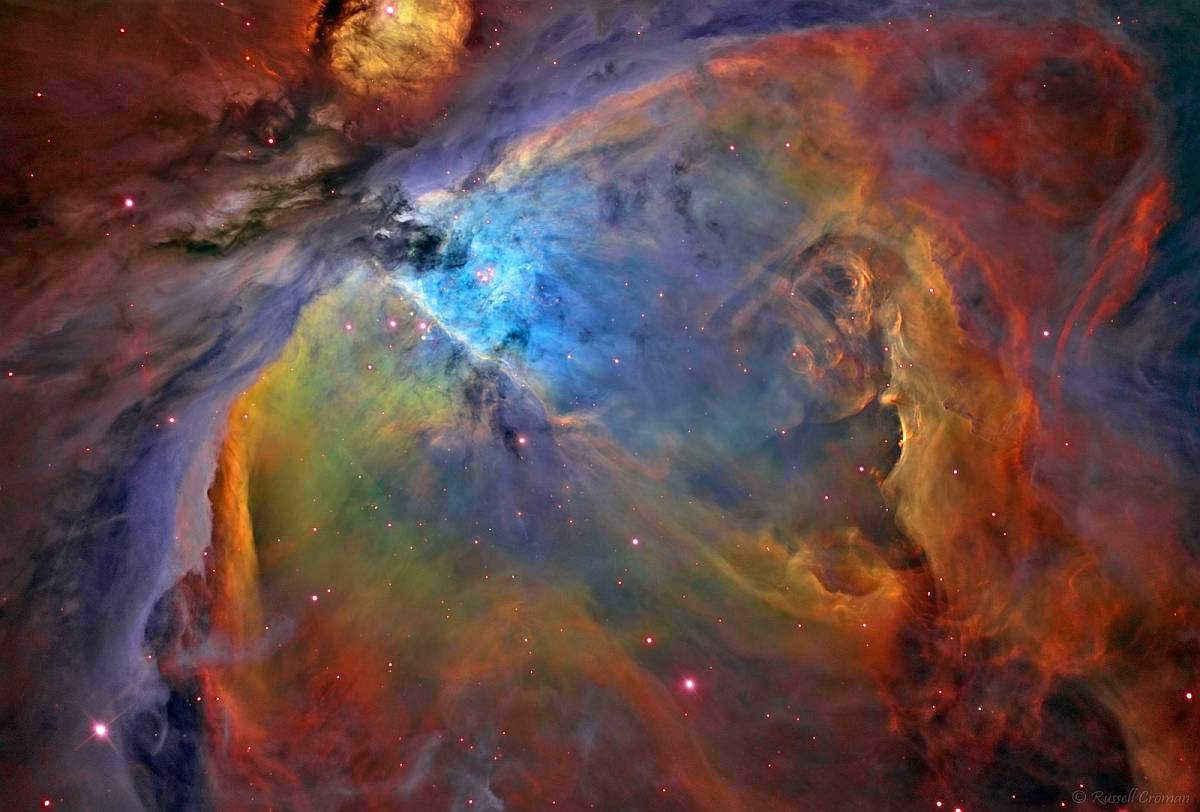
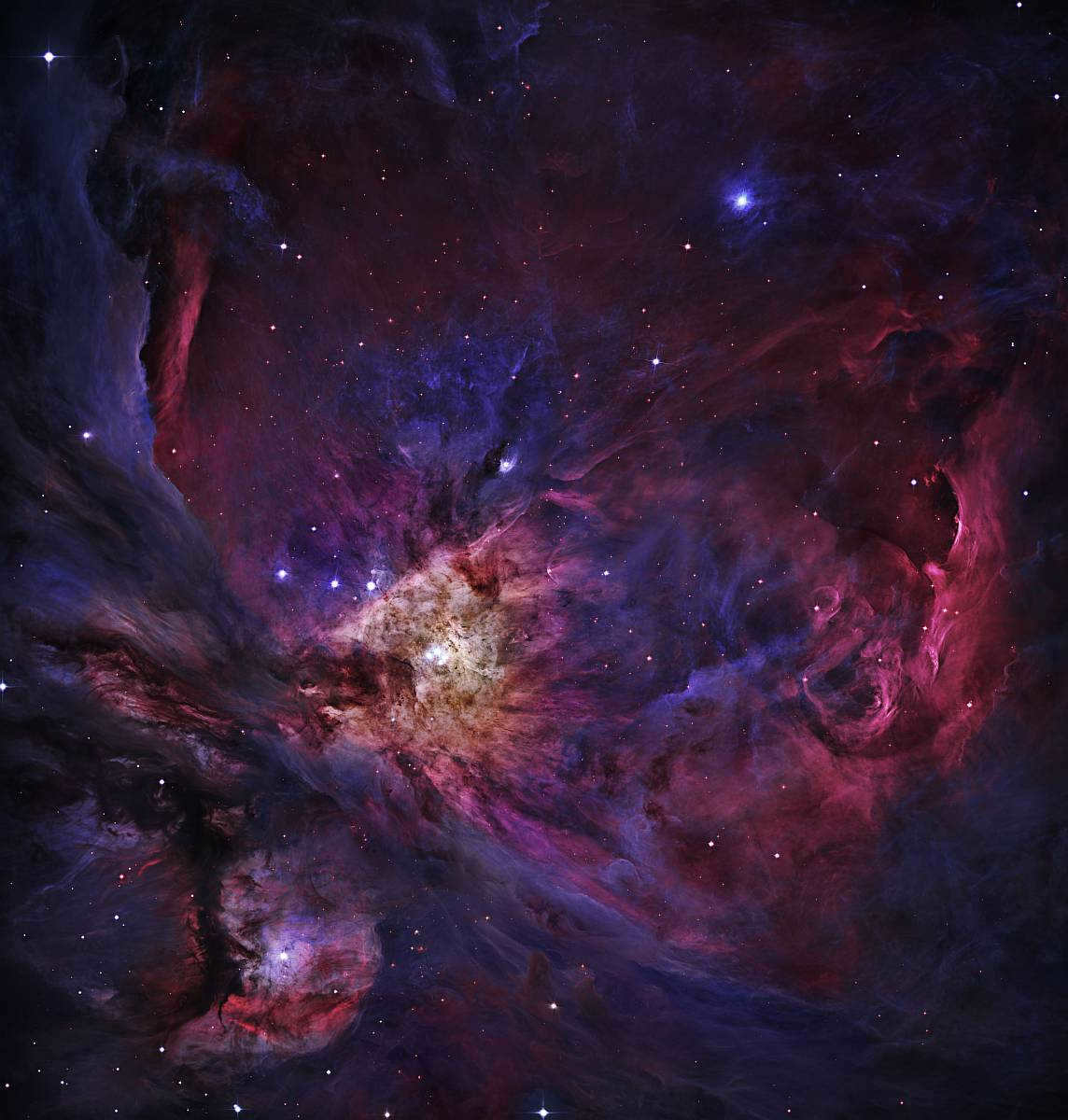
There is another option available for the nebula.
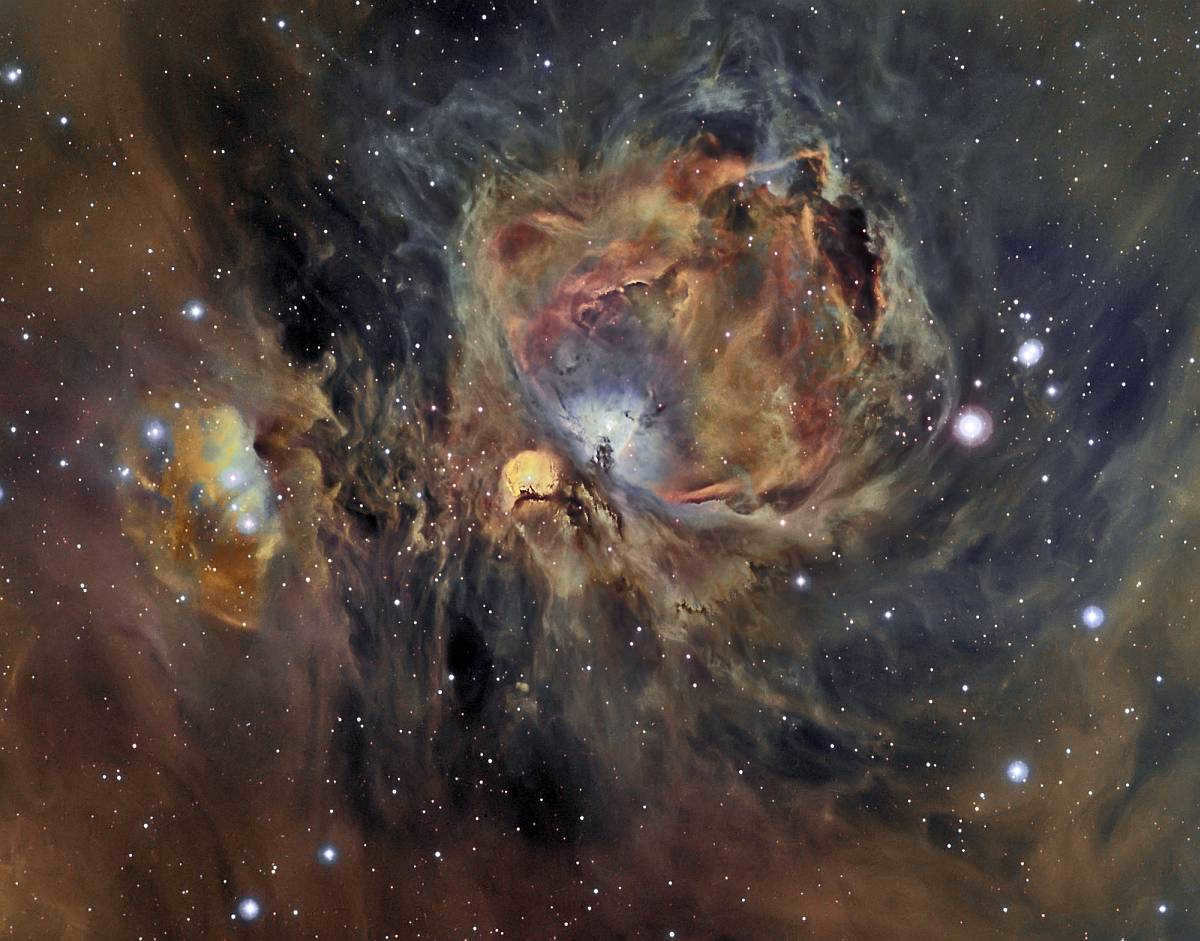
The Horsehead Nebula is a celestial object with a distinct shape resembling the head of a horse.
Here is a photo of the Horsehead Nebula
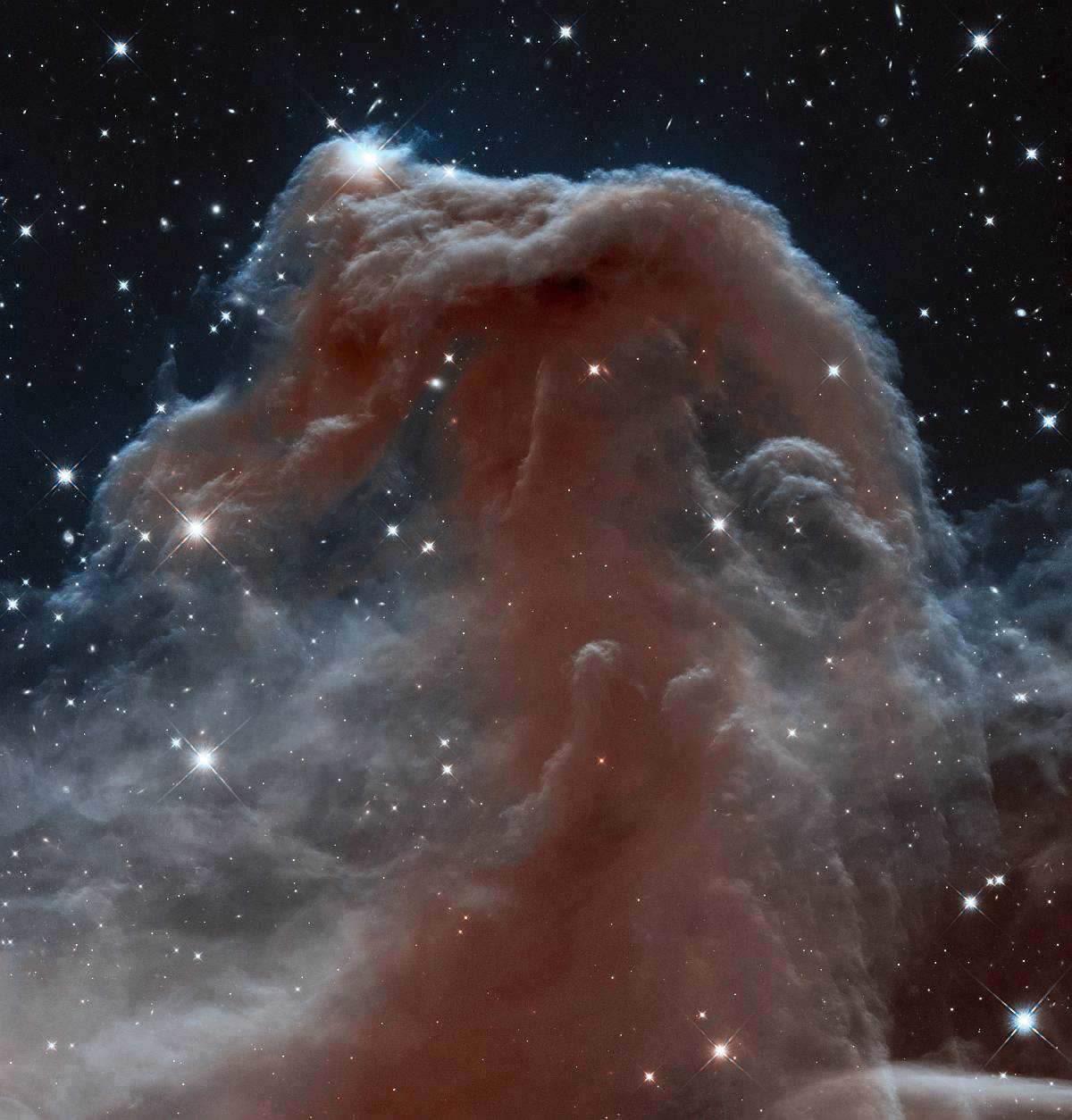
Enlarged fragment of the Horsehead Nebula photo
Constellations
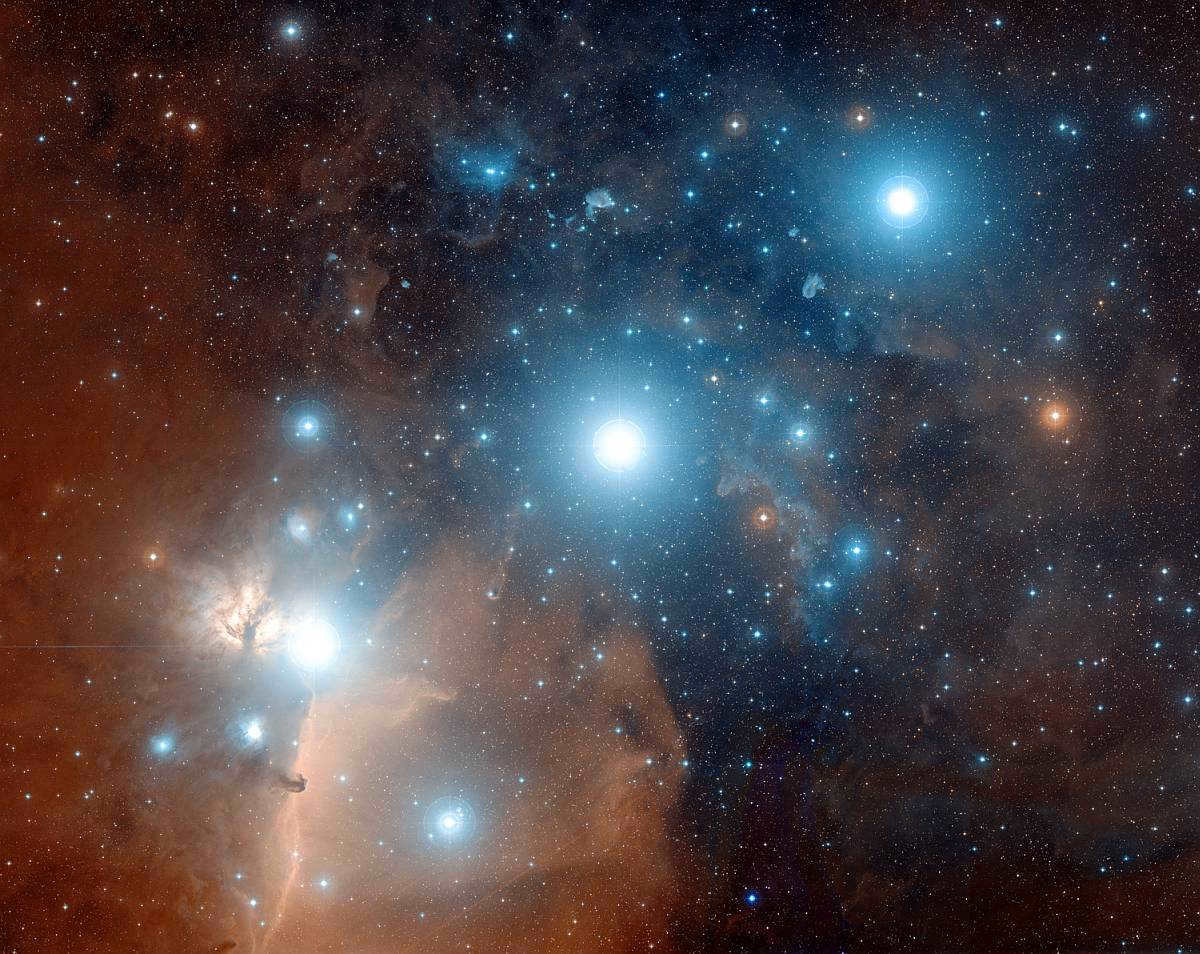

Image of Orion’s Belt Asterism
Orion contains several notable asterisms, namely the Butterfly, Magus, Belt, Sword, Shield, Bludgeon, Mirror of Venus, and Pan. These asterisms are intricately connected to each other and together form the entire constellation.
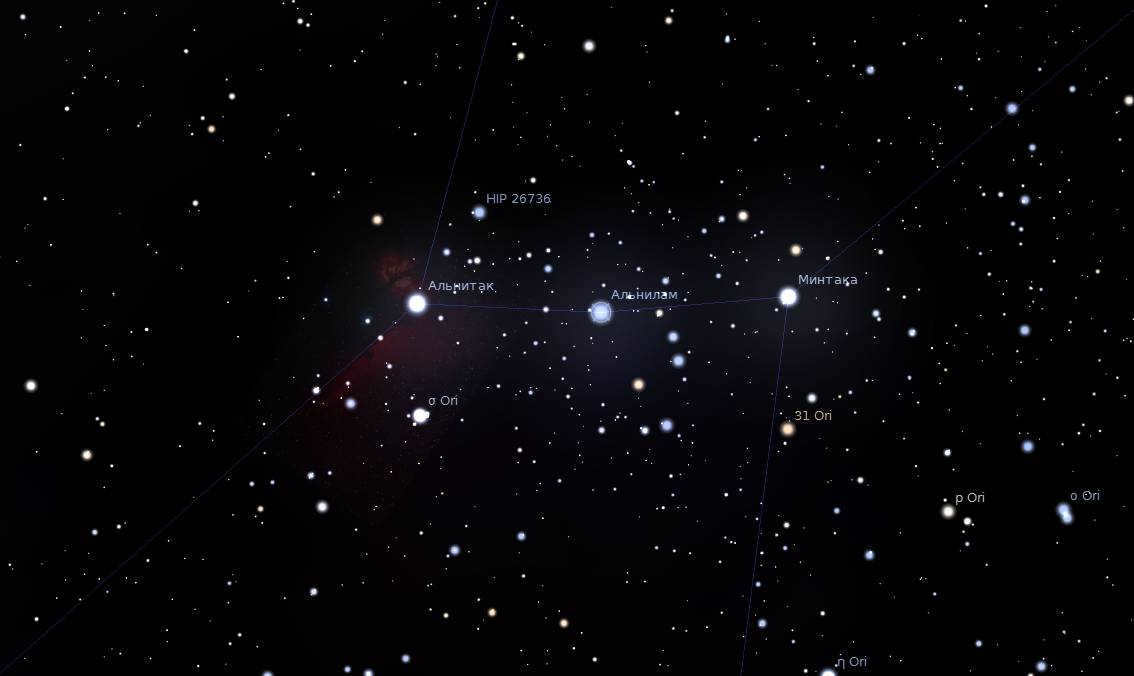

Image of Orion’s Belt captured from a digital planetarium software
Historical Background
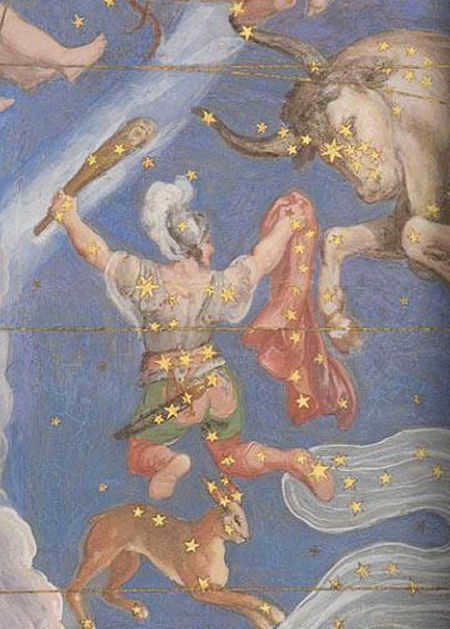
The constellation Orion, depicted in a historic celestial map
In the ancient civilization of Egypt, this particular constellation held the esteemed title of the ruler of the stars. The ancient Babylonians referred to it as the “Loyal Guardian of the Celestial Realm.” In Greek mythology, the arrangement of stars resembled a human figure. Orion is recognized as the offspring of Poseidon and Euryale. Poseidon then bestowed upon him a place among the celestial bodies. It is prominently featured in the Almagest star catalog.
A concise exploration of the constellation
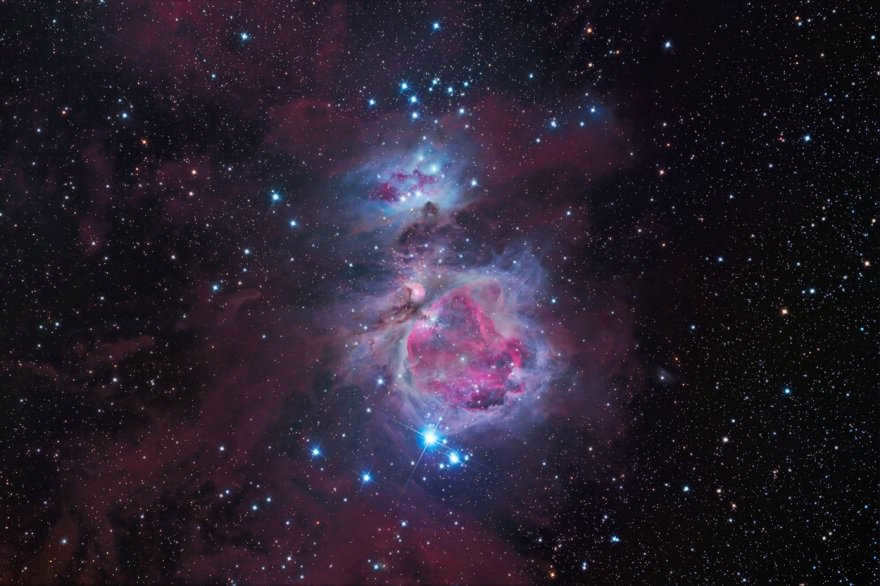
Discovering the Orion Nebula (M 42, NGC 1976) in the Orion constellation can be an exciting experience. With the help of a telescope or binoculars, you can observe this luminous emission nebula, which is located approximately 1,344 light-years away from Earth. The Orion Nebula, also known as Messier 42, is one of the most prominent nebulae in the night sky, with a brightness that reaches an apparent magnitude of 4.
May 3, 1764.
A celestial object known as a nebula was discovered positioned between the Wolfhound and one of the Hound Dogs in the constellation of Hevelius. This nebula does not contain any stars, but its center emits a brilliant light that gradually fades away. It has a round shape and can be observed with a 1-foot telescope under favorable sky conditions. This nebula was documented on a comet map from 1779 and mentioned in the Memoirs of the Academy for the same year. It was also observed again on March 29, 1781, and was described as incredibly beautiful with a diameter of 3 arcminutes.
Observational data and physical characteristics of the Orion Nebulae
| History of the research | |
| NGC 1976, M 42 | |
| Observational data | |
| Emission nebula | |
| 05 h 35 m 16.4789 s | |
| -05° 23′ 22,844″ | |
| 1344 ± 20 light years | |
| 85 × 60 ′ | |
| Orion | |
The Orion Nebula can be found beneath Orion’s Belt. It presents itself as a hazy star located in the Sword of Orion, which is situated to the south of the belt. This celestial object can be observed using binoculars or a small telescope. When viewed in the night sky, it will appear four times larger than the visible Moon. Despite its size, a small instrument is able to resolve the four most brilliant stars that comprise the open cluster known as Orion’s Trapezium. These stars are massive and bright, and they were formed within the M 42 region. Their radiance serves to illuminate the nebula, and this process can be witnessed in a photograph taken by the Hubble Space Telescope.

You can easily locate Orion because its shape resembles an hourglass. Above and below it, you’ll find Betelgeuse and Rigel. The belt of Orion is formed by Alnitak, Alnilam, and Mintaka. The best time to observe it is during winter.
The Orion Nebula has a size of 65 x 69 arc minutes (equivalent to a diameter of 24 light-years). It has a mass 2000 times greater than that of the Sun. It contains stellar associations, reflecting nebulae, and neutral clouds composed of dust, gas, and ionized gas. It is part of the molecular cloud group in Orion, which also includes the Horsehead Nebula, the Flame Nebula, and Barnard’s Loop. Additionally, Messier 43 and Messier 78 are also notable in this complex. This entire complex spans 10 degrees, which is half of the Orion constellation.
M 42 is a highly dynamic region where stars are constantly being born, making it a prime location for scientific investigation into the processes of star formation and evolution. The nebula exhibits ongoing star formation, which is evident throughout. At the core of M 42, the temperature reaches a scorching 10,000 K.
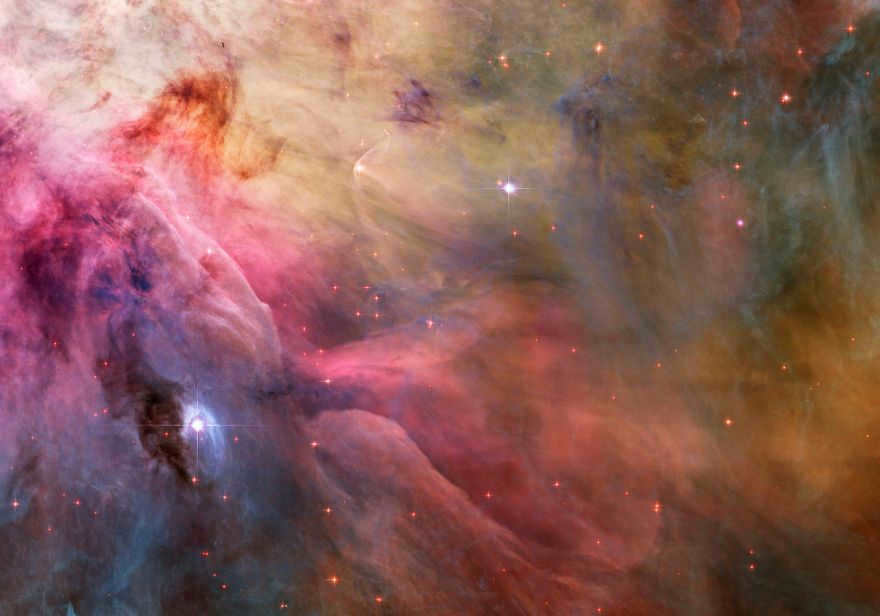
Discover the breathtaking beauty of the Orion Nebula (M42).
The Trapezium cluster’s dazzling stars emit ultraviolet light, which warms the surrounding gas and lights up the nebula. Furthermore, the stellar wind sculpts the nebula into its mesmerizing form. The majority of the ultraviolet rays originate from Theta 1 of Orion C, the most massive star in the Trapezium. It belongs to the O6pe V spectral type and boasts a surface temperature of 40000 K.
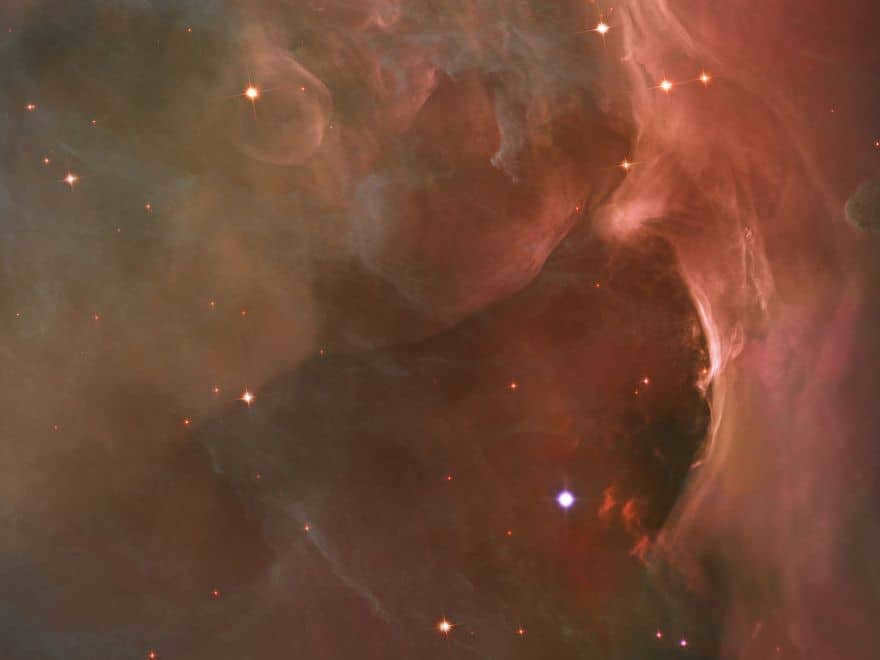

The luminous region displays the formation of bubbles and arcs when streams of charged particles known as stellar winds collide with material.
The Orion Nebula consists of various parts, each with its own unique name. The bright regions on the sides are referred to as the Wings, while the dark line extending from the north to the bright area is known as the Mouth of the Fish. To the south, there is a prominent extension called the Sword, and to the west, a fainter one known as the Sail. Additionally, there is a noticeable bright area below the Trapezium cluster called Zasov.
The Hubble telescope managed to photograph over 150 protoplanetary disks, which represent an early stage in the formation of systems.
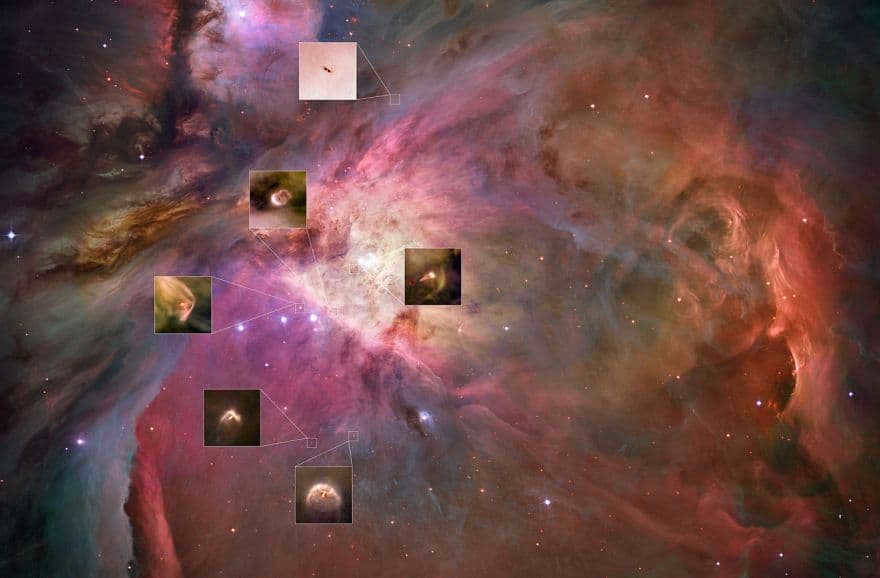
There is a belief that in another 100,000 years, the majority of the Orion Nebula will vanish, and what will remain is a vibrant and youthful cluster enclosed by remnants.
Interesting Information about the Orion Nebula
Due to its brightness, numerous ancient civilizations were aware of its presence. M 42 was referenced in ancient Mayan creation mythology, symbolizing burning embers.
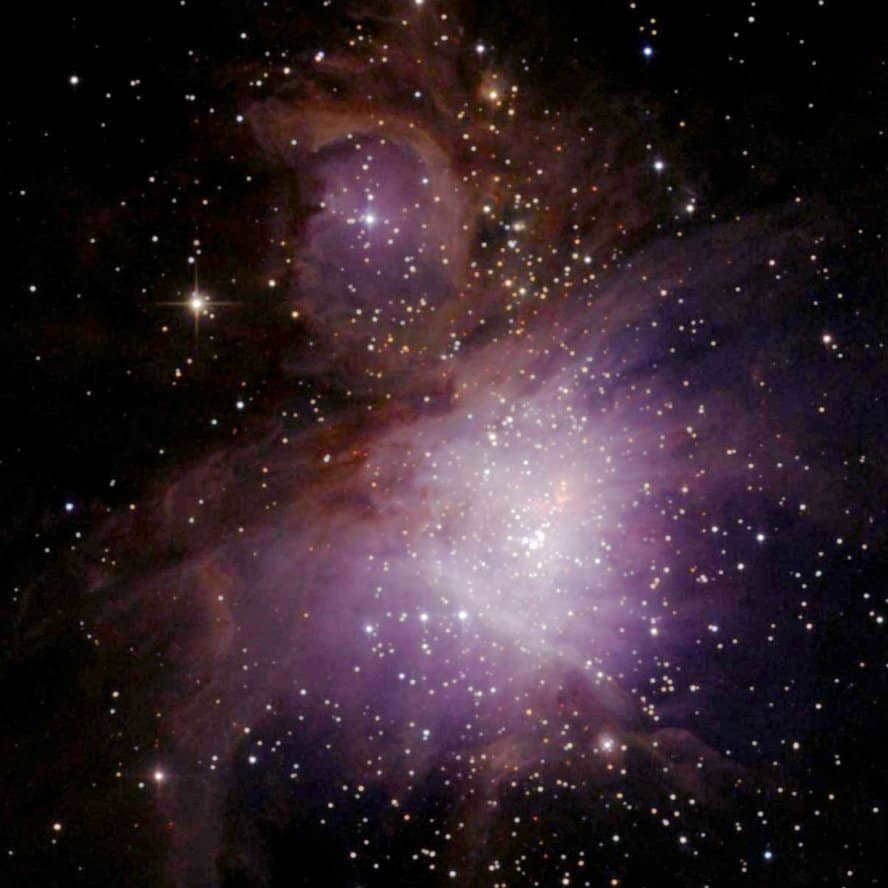
Created within the 2MASS project, this image displays the captivating M42 nebula.
Ptolemy and Galileo, renowned astronomers, observed and documented numerous celestial objects, but interestingly, they did not make mention of the nebula itself. Ptolemy, for instance, only noted one bright star within M42 during his observations in 130 AD. This observation was later confirmed by Tycho Brahe in the late 16th century and Johann Bayer in 1603, who referred to it as Theta of Orion. In 1610, Galileo observed three bright stars in the same region but failed to identify the nebula surrounding them.
The object’s true identity was unveiled by Nicola-Claude Fabry de Peyresque when he observed the nebula on November 26, 1610. The initial reference in a publication came in 1619 from Johann Baptiste Cisat, who likened it to a comet sighted in 1618: “I perceive the stars contracting within a confined area and emitting a white radiance resembling a cloud.”
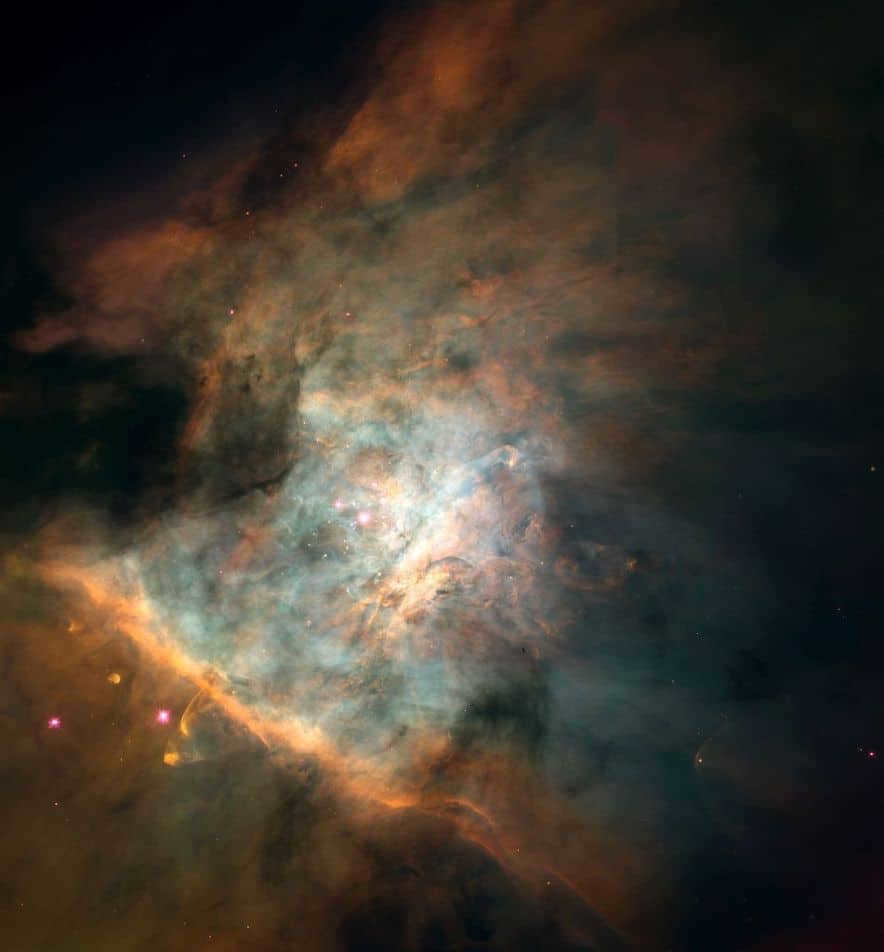
The Orion Nebula is depicted in its true colors.
Cisat was also the first to provide a brief description of the Trapezium in Orion, noting that the central stars were arranged in a rectangular shape. However, credit for the discovery is still given to Galileo Galilei, who observed three stars on February 4, 1617.
The initial sketch of the Orion Nebula was created by Christian Huygens in 1656: “There is a phenomenon that is difficult to observe and has not yet been documented by anyone. In Orion’s sword, there are three closely spaced stars. In 1656, I measured the middle one using a 23-foot refractor and found it to be 12. Three of them are almost touching, and four shine so brightly that this section stands out from the rest.”
Giovanni Gaudierna was the first to draw the nebula, depicting the three stars from Orion’s Trapezium.
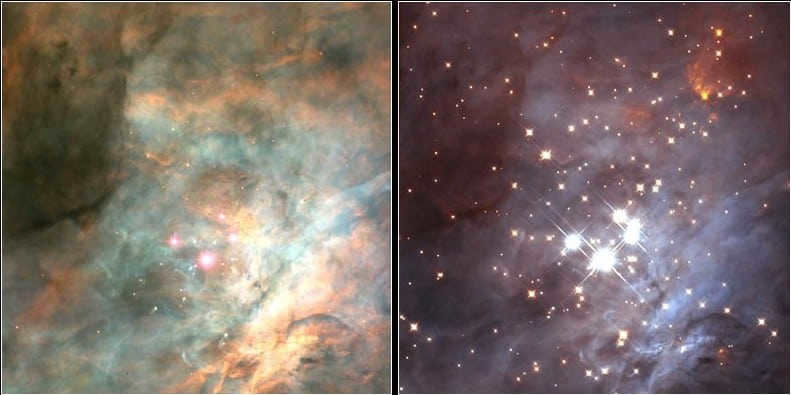

Hubble has provided two distinct views of Orion’s Trapezium. The first image showcases an optical spectrum that displays stars enveloped in blazing gas and dust, while the second image, captured in infrared, has the ability to penetrate through the haze and capture stars as well as brown dwarfs.
On the 4th of March, 1769, Charles Messier made the remarkable discovery of the nebula and the three stars that comprise Orion’s Trapezium: “A magnificent nebula located in the sword of Orion, surrounding the star Theta. There are three additional smaller stars that cannot be observed without the aid of advanced instruments.”
Curiously, M 43 was distinguished by Messier as an individual entity within the northeastern region of the nebula.
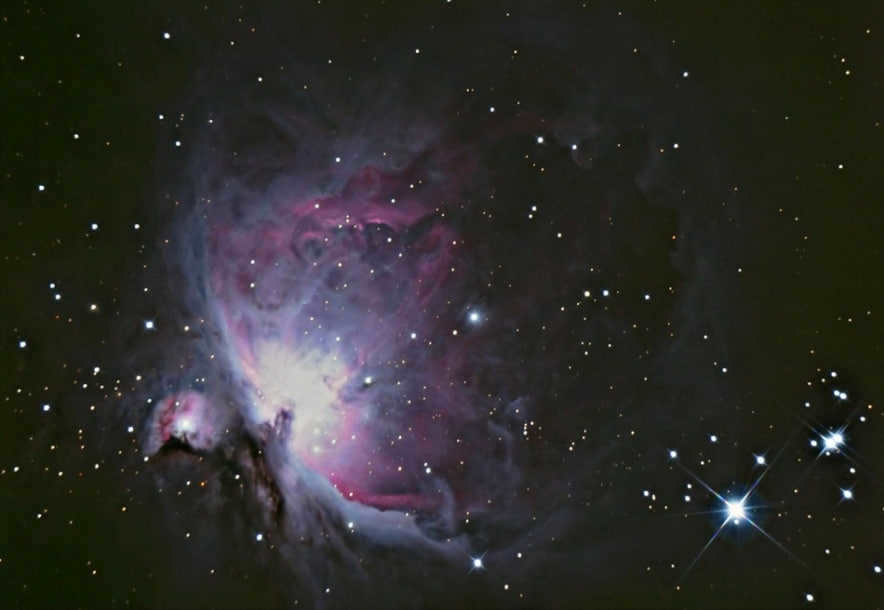
North of M 42, you can find several dim nebulae known as NGC 1973, NGC 1975, and NGC 1977. These nebulae partially reflect the light emitted by the Orion Nebula. Heinrich D’Arré discovered NGC 1973, NGC 1975, and NGC 1977, while William Herschel found the last one.
In 1774, William Herschel observed the Orion Nebula using his 6-foot telescope, making it the first deep-sky object he ever studied. “Nebulae have a tendency to be interconnected with each other. For instance, we have discovered 14 such objects. M 42, located in the constellation of Orion, is the largest among them. It is also the nebula closest to Earth and provides valuable scientific data,” he said.
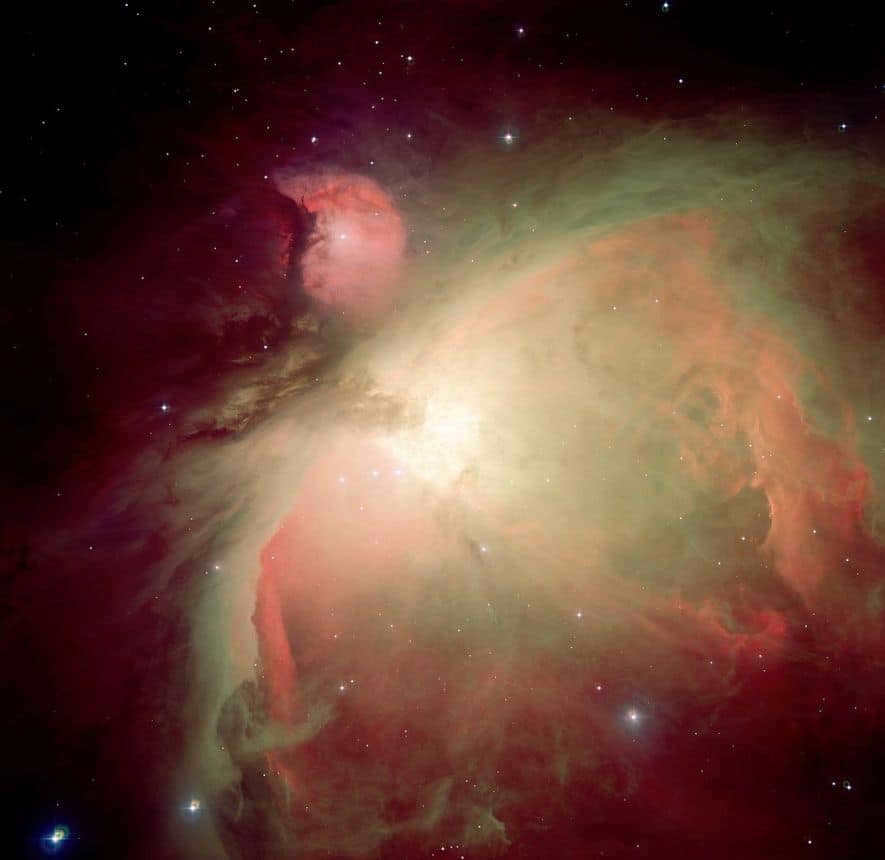

The breathtaking Orion Nebula, taken by the 2.2-meter telescope of the European Southern Observatory
Johann Bode commented, “This nebula is truly extraordinary, spanning 6′ across the sky. The star Theta, which Flamsteed described as a double, is clearly visible. Two other stars can be observed to the east of it. I believe there are at least 7 stars present within the nebula.”
In January 1834, William Henry Smith remarked, “I can see a magnificent trapezoid shape in the Mouth of the Fish, as well as a massive nebula. Ptolemy and Tycho Brahe estimated the star Theta to be of 3rd magnitude. I suppose they believed the entire bright spot to be a single star.”

This is a comprehensive view of the Orion Nebula, situated 1,350 light-years away. It was captured by the VISTA infrared telescope in Chile. The expansive field of view allows for the full-scale display of M42, while the infrared observation bypasses the obstructive effect of dust, unveiling the concealed areas where young stars reside. The image was obtained using Z, J, and Ks filters, with an exposure time of 10 minutes for each filter. The depicted area spans 1 x 1.5 degrees.
In 1865, William Haggis utilized the technique of visual spectroscopy and determined that the nebula consisted of “luminous gas”: “The prisms separated the light of the bright components into three distinct lines. These lines signify the presence of gas, with the spaces between them appearing dark.”
The first nebula to be captured in a photograph was M 42. This groundbreaking event occurred on September 30, 1880, courtesy of Henry Draper and his utilization of an 11-inch refractor along with the innovative dry-plate technique.
In 1883, Andrew Common further refined the details of this celestial object through his own images. Common employed dry plates and a massive 36-inch reflector for his observations, which required a lengthy exposure time of one hour.
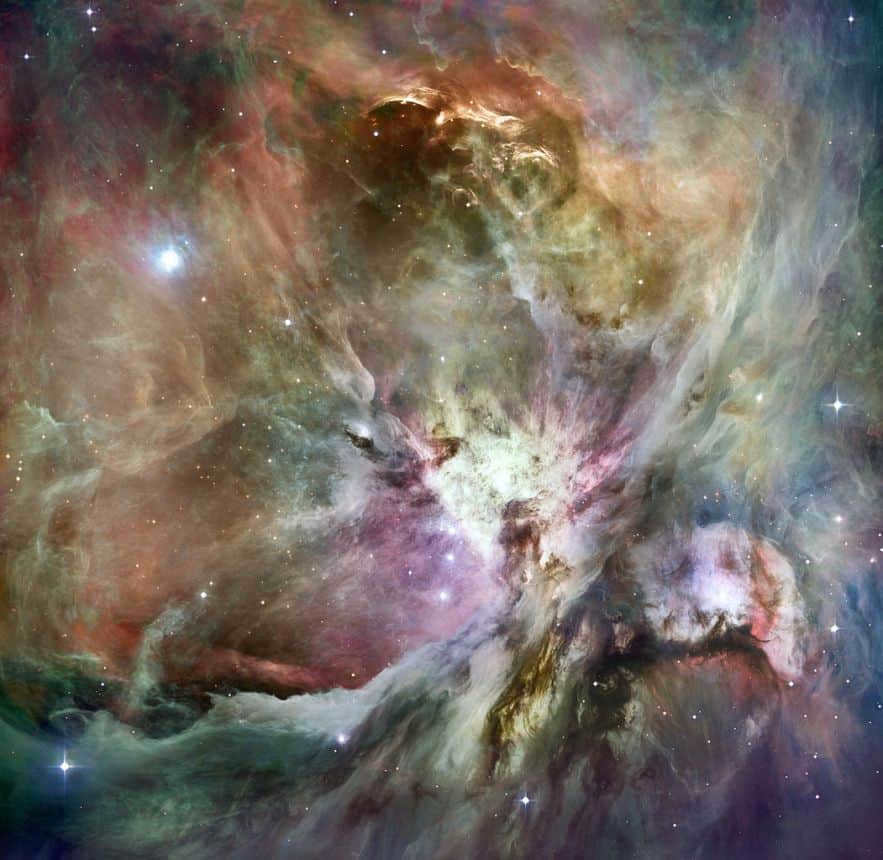

This stunning composite image showcases the beauty of the Orion Nebula, captured through the lenses of both the Hubble and Spitzer telescopes.
Originally named Orion’s Trapezium by Robert Trumpler, this cluster is estimated to be located approximately 1,800 light-years away. The first breathtaking images of this nebula were acquired by the Hubble telescope in 1993.
Whether you explore the Hubble photo of the Orion Nebula (M 42) or utilize our online telescopes and 3D models to observe stars within galaxies and constellations, our star map for all seasons will guide you on your celestial journey.
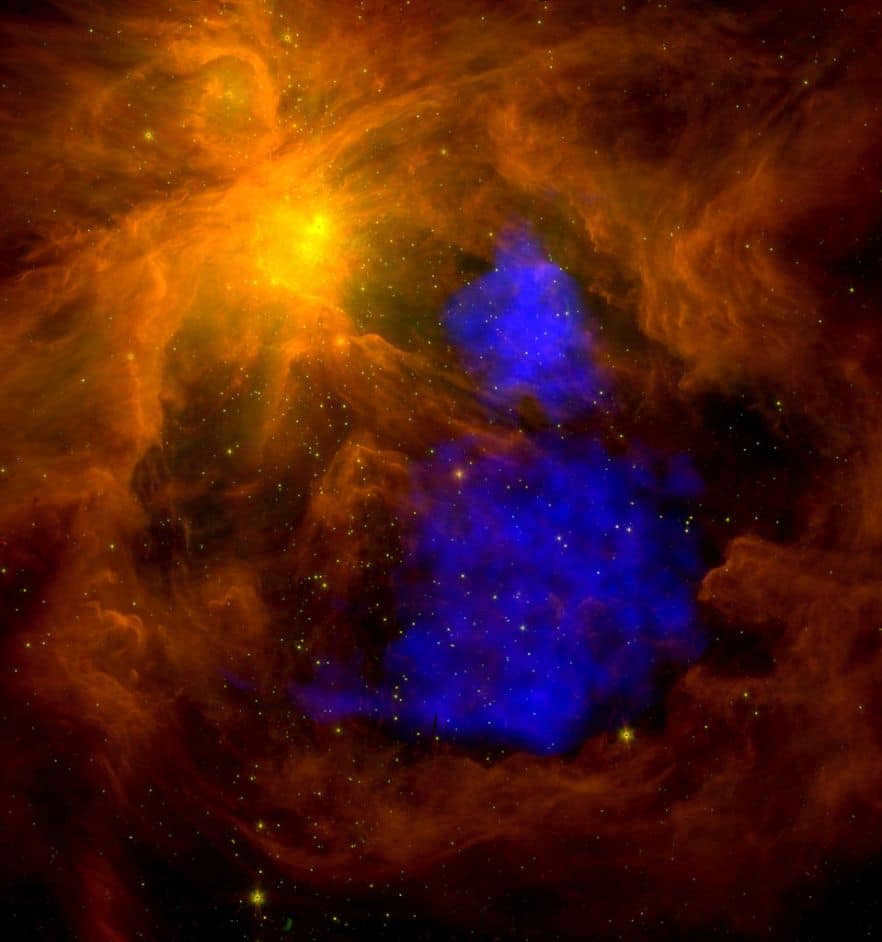
The picture displays M42 in the Spitzer infrared observation along with XMM-Newton X-ray data (blue).
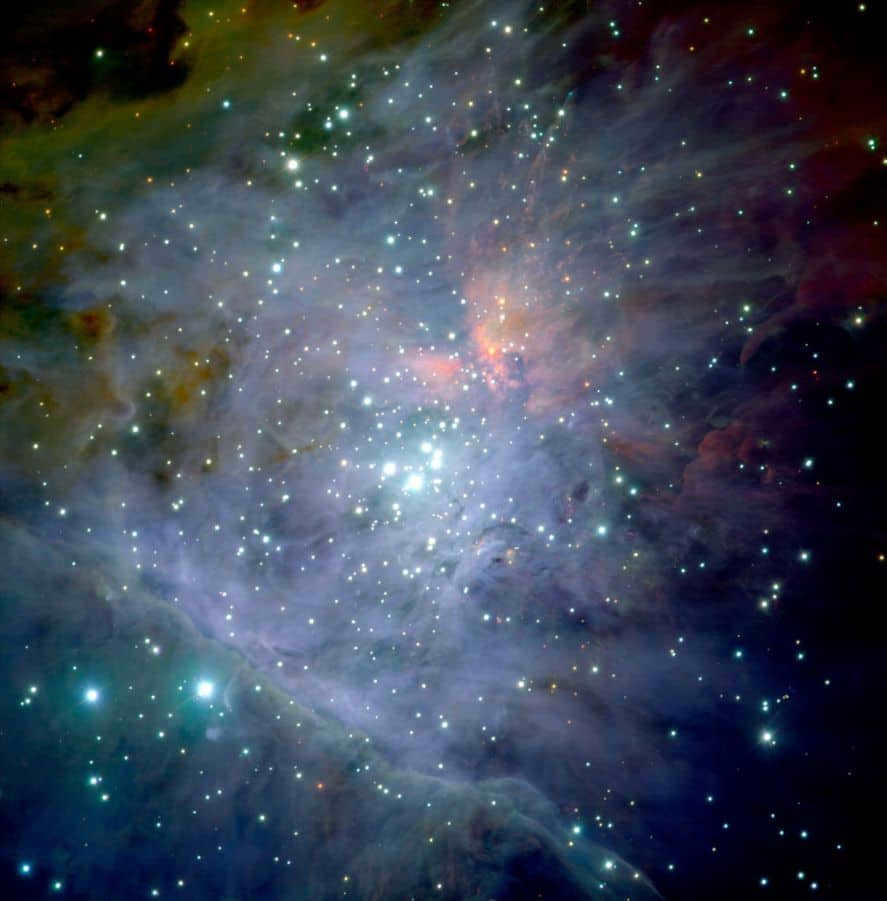

The central part of M42 was photographed by the Very Large Telescope, producing a colorful composition. The image was created by combining a series of 81 individual photos. The stars of Orion’s Trapezium are clearly visible in the center of the image, along with the surrounding cluster of thousands of stars that are believed to be around a million years old.
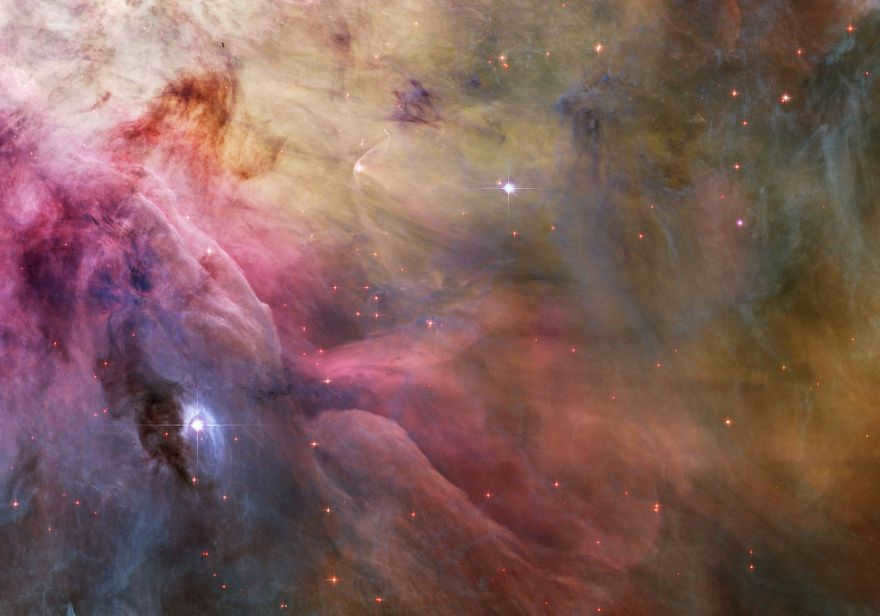
Right in front of you, there is a stunning image capturing the collision of cosmic clouds and winds in the LL Orion and M42 stream. LL Orion is a star that goes through variations in its brightness and its wind energy surpasses that of our own Sun. As it moves at an incredible speed, it collides with the slow-moving gas, resulting in the formation of a shock wave. Positioned slightly above the left and towards the center, you can observe a head shock wave that spans half a light-year in size. The slow-moving gas is seen moving away from Orion’s Trapezium, located at the top left. The shock wave takes on the form of a vibrant bowl, representing a vast stellar breeding ground filled with various liquid forms that contribute to the formation of new stars.
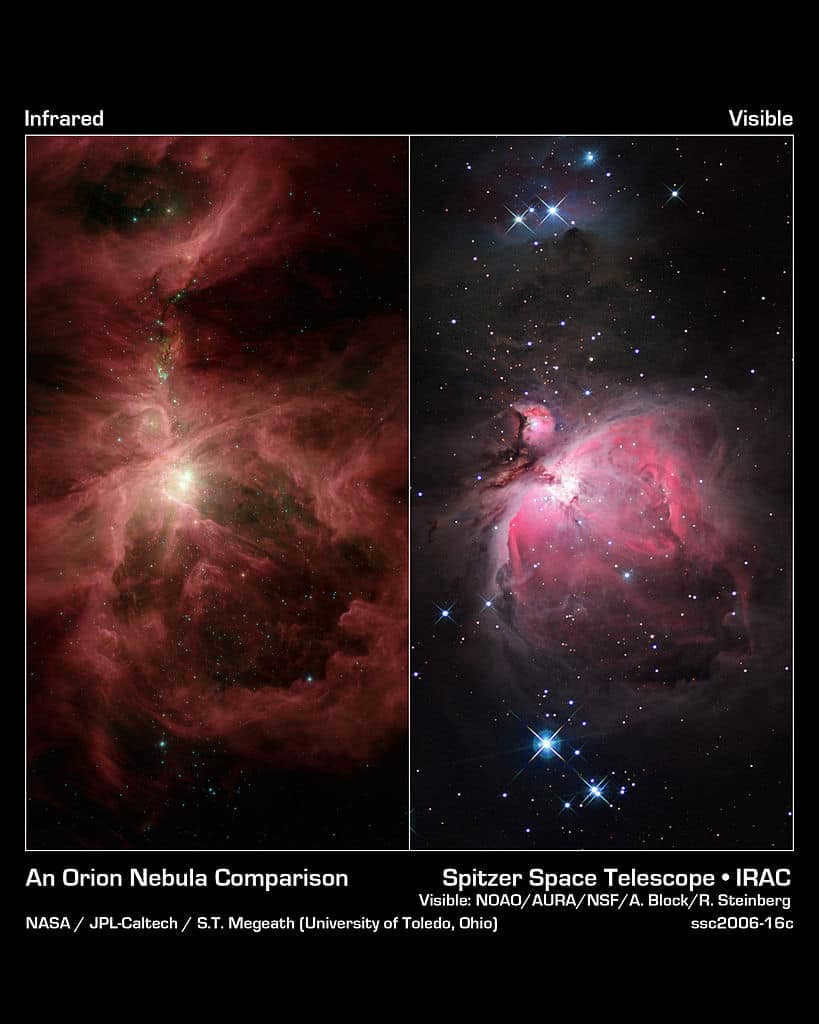
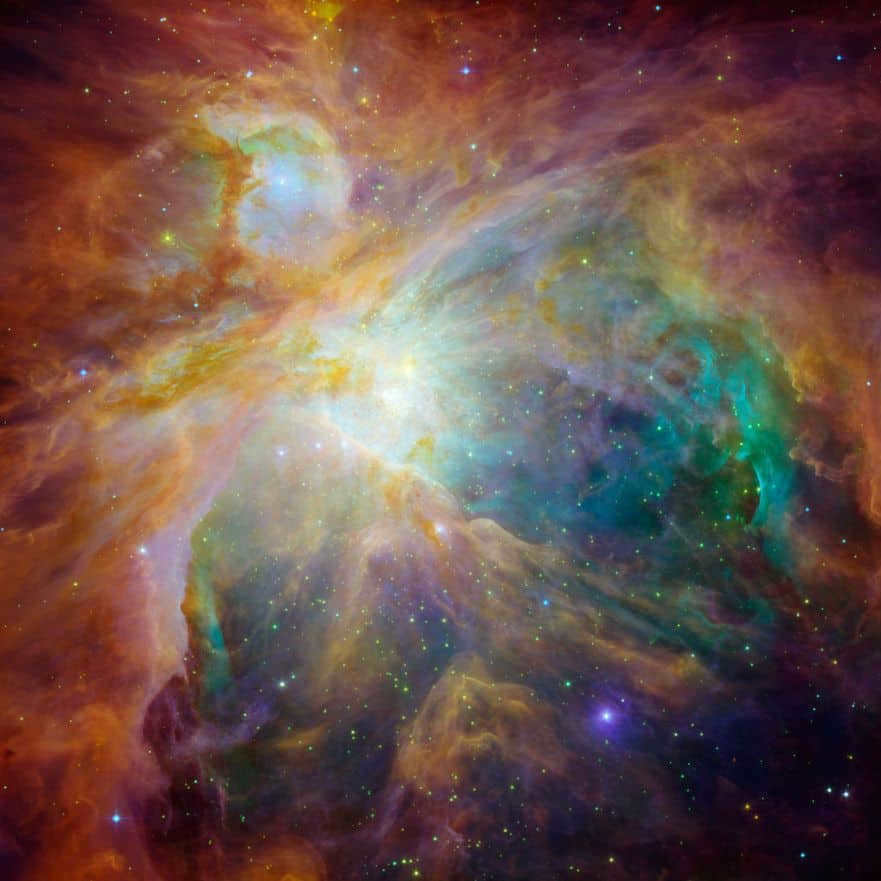
The 4 massive central stars (yellow spot near the center) are clearly responsible for the glow, as seen in the vivid image captured through infrared observation and visible light. The swirls of green (captured by the Hubble Ultraviolet light) showcase the presence of hydrogen and sulfur gas, which have been heated by the radiation emitted by the Trapezium stars. Additionally, the Spitzer telescope has identified the existence of carbon-rich molecules (depicted in shades of red and orange), which are similar to those found in automobile exhaust on Earth. Both telescopes depict the nebula as a dazzling stellar rainbow, with orange and yellow stars representing young stars concealed within dust cocoons, green stars indicating more exposed and dust-free regions, and blue stars representing foreground stars. Furthermore, the large depression located on the right side of the image may have been formed as a result of the powerful winds generated by the Trapezium stars.
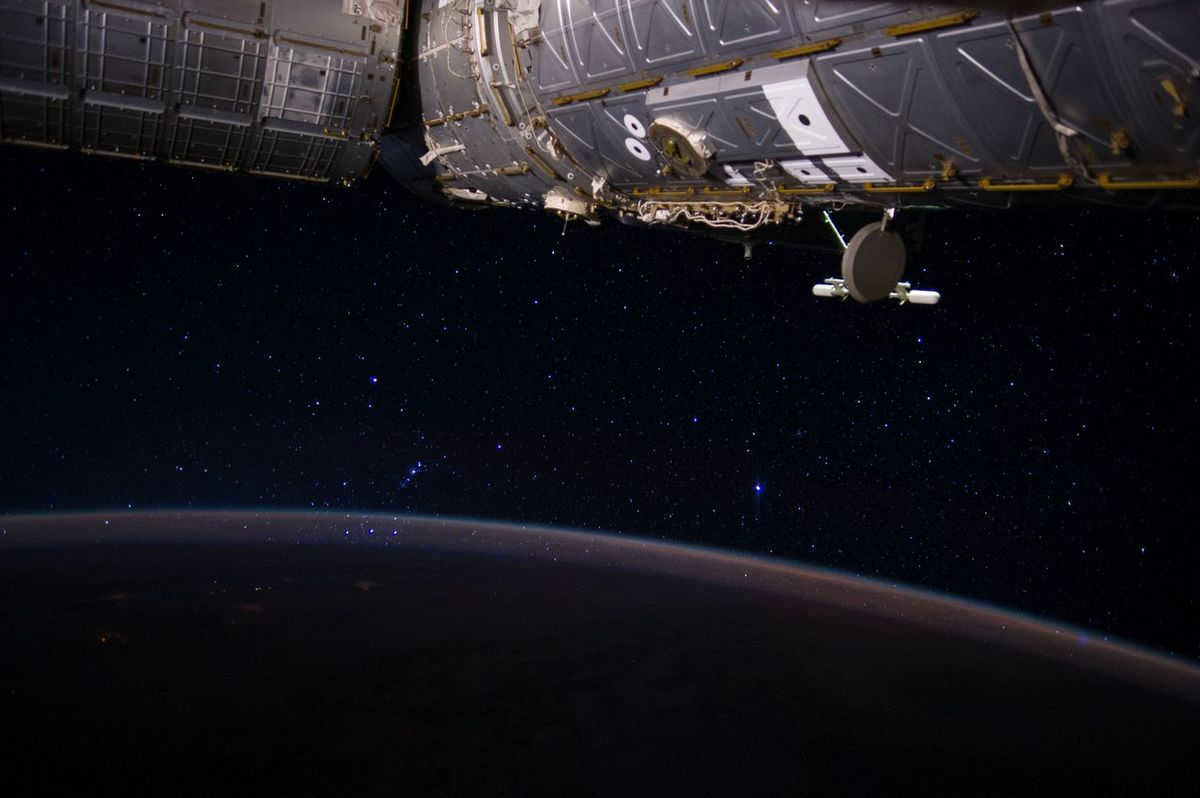

The constellation Orion contains a trio of stars known as the belt. Situated along the celestial equator, this constellation is visible from various parts of Russia.

The celestial bodies Alnitak, Alnilam, and Mintaka have served as crucial points of reference for both ancient explorers and ancient religious structures, such as the pyramids on the Giza plateau. These stars continue to hold significance as their positioning in the heavens has been mirrored on Earth.
Alnitak
Alnitak, also known as Zeta Orionis, is a bright blue supergiant star located in the constellation Orion. It is one of the three stars that form Orion’s Belt, along with Alnilam and Mintaka. Alnitak is approximately 800 light-years away from Earth and has a diameter about 20 times that of the Sun. It is one of the most prominent stars in the night sky and is easily visible to the naked eye. Alnitak is a young star, estimated to be only about 4 million years old. It is classified as an O-type star, which means it is extremely hot and emits intense ultraviolet radiation. The star is surrounded by a large disk of gas and dust, indicating that it may have a planetary system in the process of formation. Alnitak is also known for its association with the famous Horsehead Nebula, a dark cloud of gas and dust that appears to be in front of the star when viewed from Earth. This makes Alnitak an important target for astronomers studying star formation and the evolution of planetary systems.
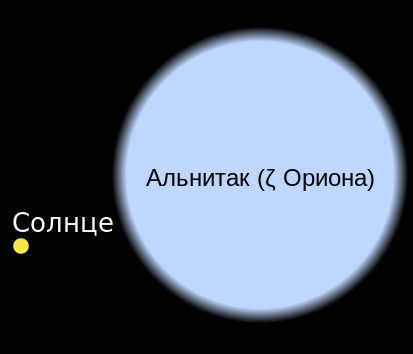
The size comparison between Alnitak and the Sun
Alnitak, the lowest star among the three, derives its name from the Arabic term “cloth belt” or “girdle”. It is located at a distance of 825 light-years from Earth and is the first brightest star of the O-class. Alnitak is a triple star system, with its main star, Alnitak A, having a mass of 28 solar masses and a radius 20 times larger than that of the Sun. This blue supergiant, belonging to the spectral class O9.7, has a surface temperature of 33,500 Kelvin. The two blue companions of the main star have luminosities of 4 and 10, respectively. The luminosity of Alnitak is 35,000 times higher than that of our Sun. The companion of Alnitak A, known as Alnitak B, belongs to the class O9.5 and completes a circular orbit around Alnitak A every 1510 years. Alnitak B also has its own companion. In 1998, a new discovery was made – Alnitak C, which has a magnitude of 10.
Alnilam
Alnilam is one of the brightest stars in the constellation of Orion. It is located approximately 1,340 light-years away from Earth. Alnilam is a blue supergiant star and is part of the Orion Belt, which also includes the stars Mintaka and Alnitak. This star has a luminosity over 275,000 times that of the Sun and a surface temperature of about 27,000 Kelvin. Alnilam is a young star, estimated to be around 4 million years old. Its massive size and brightness make it a fascinating object for astronomers to study.

The photograph of Alnilam has been obtained from the DSS catalog.
Alnilam, the second star in Orion’s belt, is also the most distant. It is one of the most brilliant stars in the night sky. This massive blue supergiant is 40 times more massive than our Sun and 26 times larger in size. Its luminosity is an astounding 375,000 times that of the Sun, and its surface temperature reaches 25,000K. Surrounding the star is the vast molecular cloud NGC 1990, which may contribute to its increased luminosity by reflecting light rays like a lens.
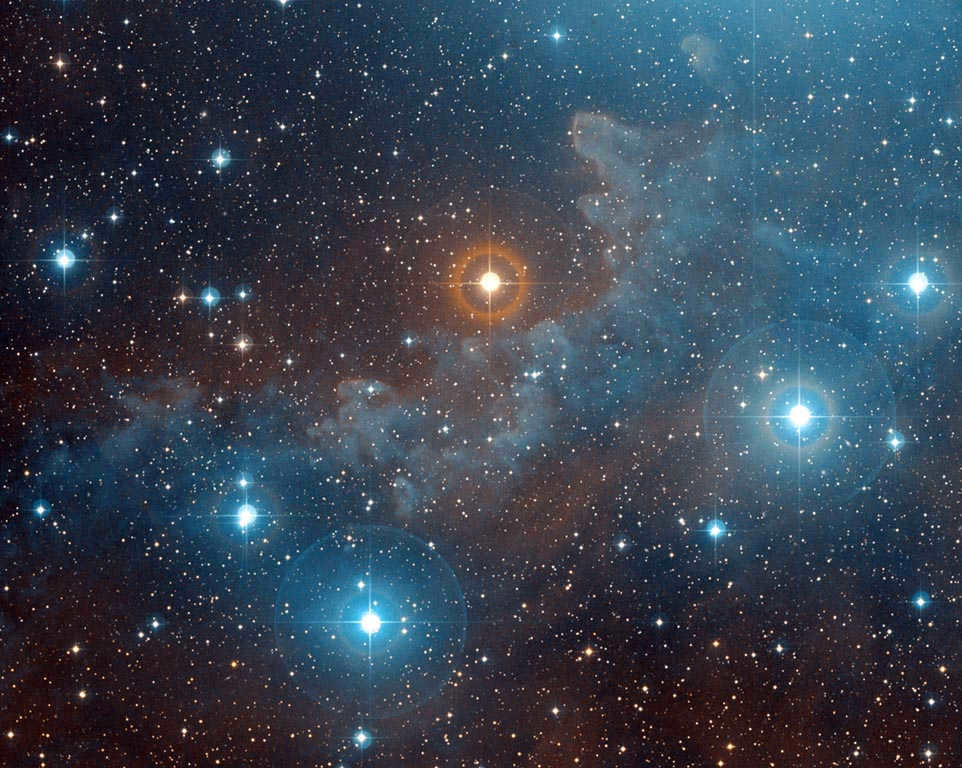
NGC 1990 molecular cloud
The massive stellar wind of the star has velocities of several thousand kilometers per hour, causing the star to shed its mass at a rate 20 million times faster than our Sun. As a result, the expelled gas forms a luminous and radiant cloud around the star. The star gets its name from the Arabic term meaning “string of pearls”. Alnilam is located at a distance of 1300 light years. In the future, Alnilam will transform into a red supergiant and eventually explode as a supernova.
Mintaka
Mintaka is a star in the constellation Orion. It is one of the three stars that make up Orion’s Belt, along with Alnitak and Alnilam. Mintaka is the westernmost star in the Belt and is located about 1,200 light-years away from Earth.
Mintaka is a hot blue star with a spectral class of O9.5II. It has a luminosity about 90,000 times that of the Sun and a surface temperature of around 30,000 degrees Celsius. The estimated mass of Mintaka is about 20 times that of the Sun.
Mintaka is a binary star system, meaning it consists of two stars that orbit around a common center of mass. The companion star to Mintaka is called Mintaka B and it is a B-type main-sequence star. The two stars are separated by a distance of about 1,500 astronomical units, which is equivalent to about 223 billion kilometers.
Mintaka is a relatively young star, with an estimated age of around 5.7 million years. It is still in the process of fusing hydrogen into helium in its core, which is what powers its luminosity. Eventually, Mintaka will exhaust its fuel and undergo a supernova explosion.
In addition to being a part of Orion’s Belt, Mintaka is also a member of the larger Orion OB1 association, which is a group of young stars that formed from the same molecular cloud. This association includes other well-known stars, such as Betelgeuse and Rigel.
Overall, Mintaka is a fascinating star with its binary system and its membership in the Orion OB1 association. Its location in Orion’s Belt makes it easily recognizable in the night sky and it is a popular target for amateur astronomers.
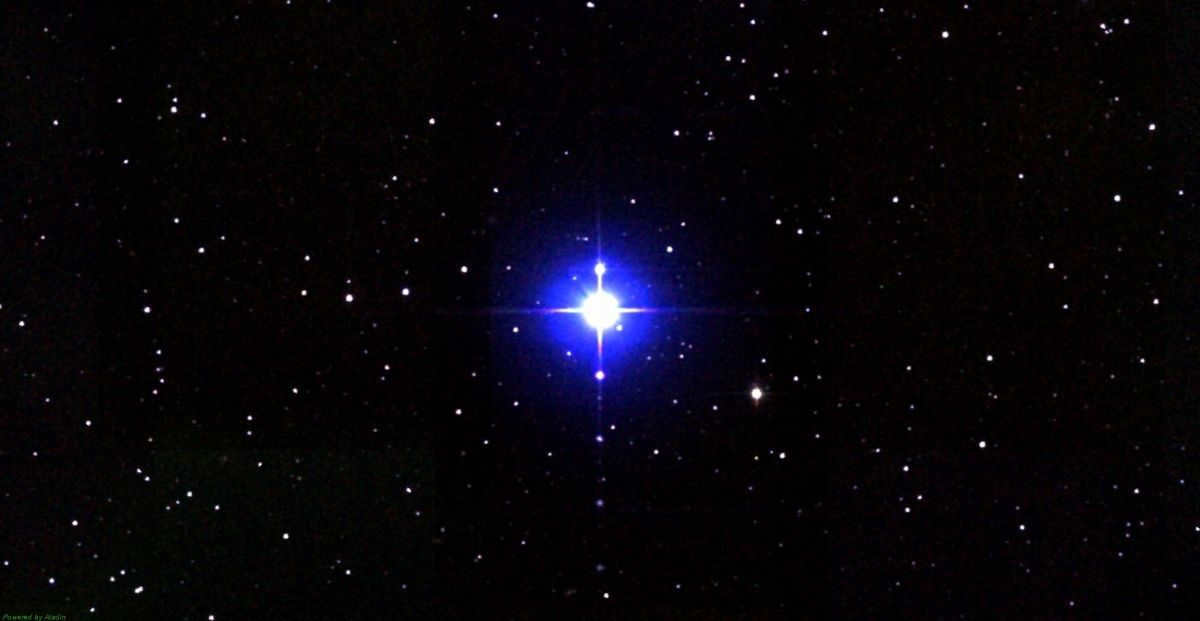
An infrared image from the DSS catalog shows the star Mintaka.
In Arabic, the last and uppermost star in Orion’s belt means “belt.” This particular star is a blue supergiant, just like the other two stars in the belt. It is located 900 light-years away, making it the farthest star in the belt. Mintaka has a companion white star and a dim star with a magnitude of 14. The main component of Mintaka consists of two white stars. These stars orbit a common center of gravity and periodically outshine each other, resulting in variations in Mintaka’s luminosity ranging from 2.26m to 2.14m. In the early 20th century, interstellar gas was first discovered around this star.
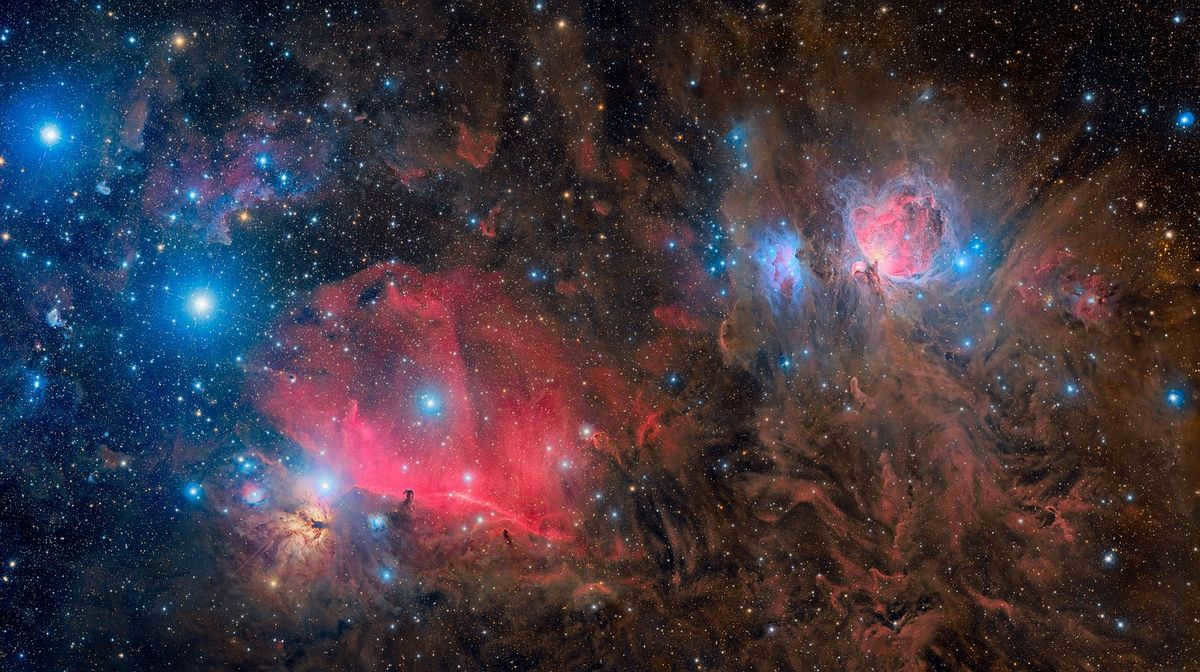

An expansive composite picture showcasing the prominent celestial feature known as Orion’s belt, alongside the neighboring nebula formations: M42, Horsehead, Flame, Witch’s Head, and various others.
The Orion Nebula
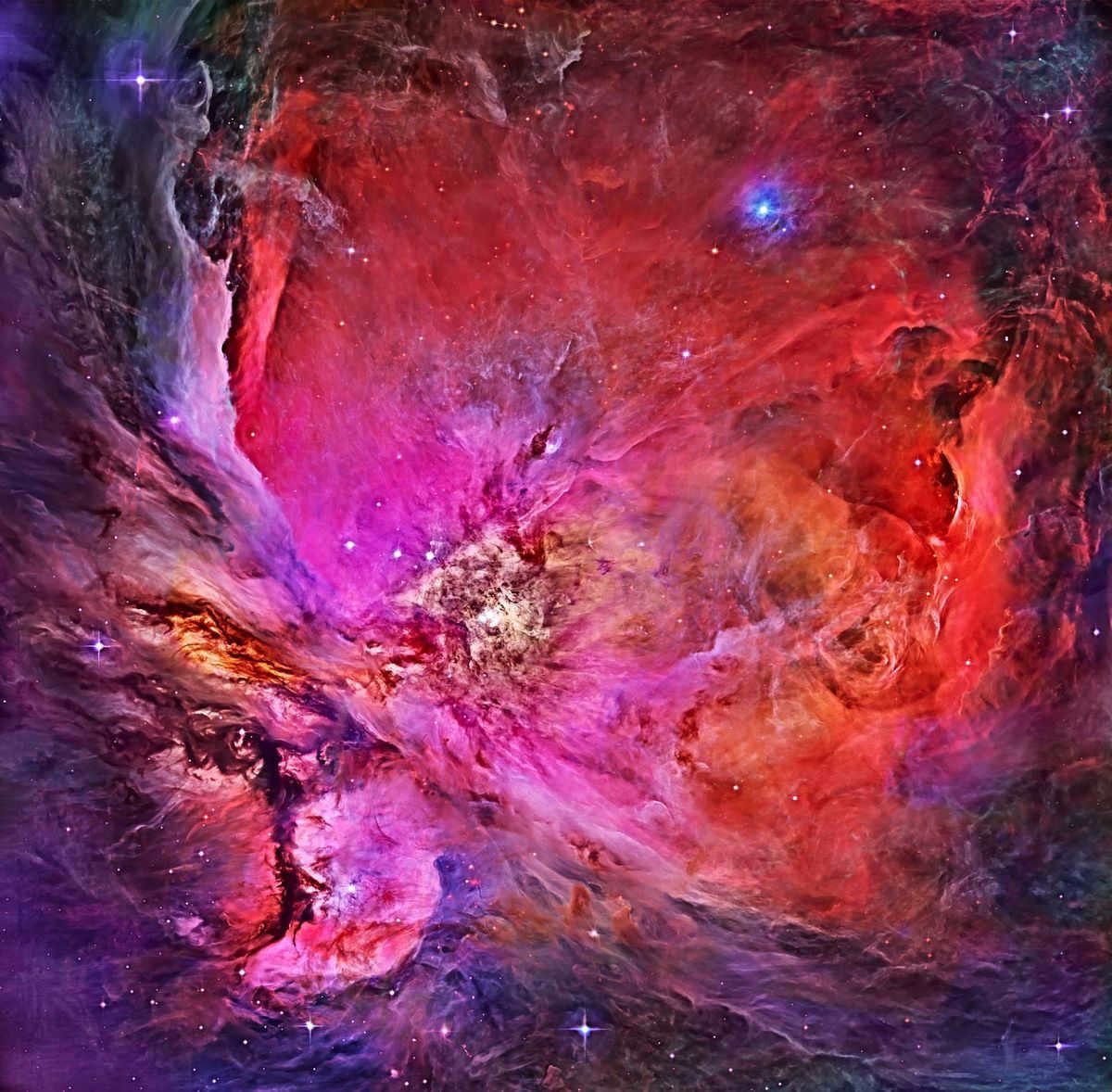
The Orion Nebula, also known as M42, is a fascinating nebula located near the Orion belt. It is the birthplace of numerous new stars within this constellation. The nebula is visible to the naked eye from any location on Earth and is approximately 1350 light years away. It spans across a distance of 35 light years. Within this nebula, scientists have discovered a protoplanetary disk and a significant amount of dust that separates different regions. At its center, there are four massive stars, while the bottom part contains stars belonging to brown dwarfs.
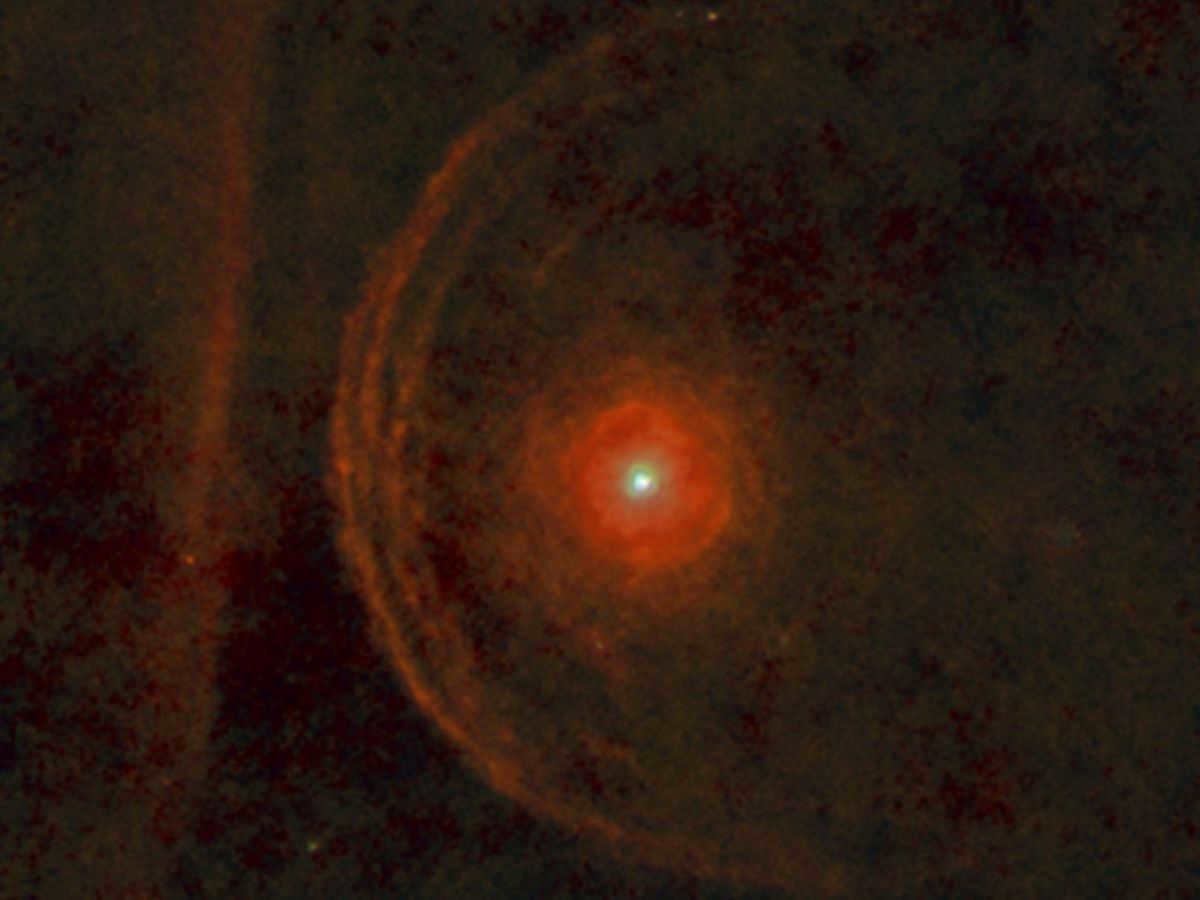
Aside from the constellation’s belt and the nebula, this grouping of stars also includes exceptionally large and incredibly hot celestial bodies like Bellatrix, which happens to be one of the brightest stars in the sky and falls under class B. Other notable stars in this constellation include Rigel, Saif, and the red supergiant Betelgeuse. It is worth mentioning that Betelgeuse has actually decreased in size by over 15% in recent years, leading to speculation that it may be on the verge of exploding as a supernova. However, it is important to note that this star is located approximately 600 light-years away from us, meaning that what we are currently observing actually transpired six centuries ago. As a result, when we gaze at and study stars and galaxies, we are essentially peering into the past.

